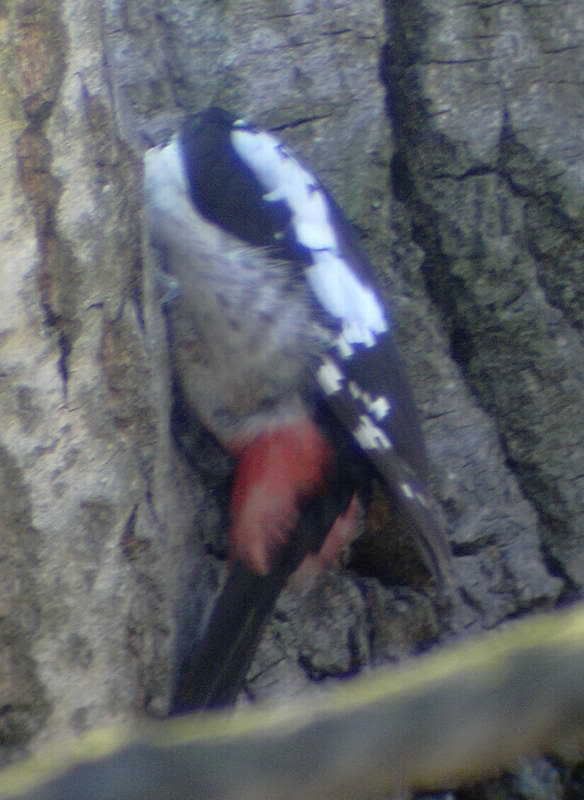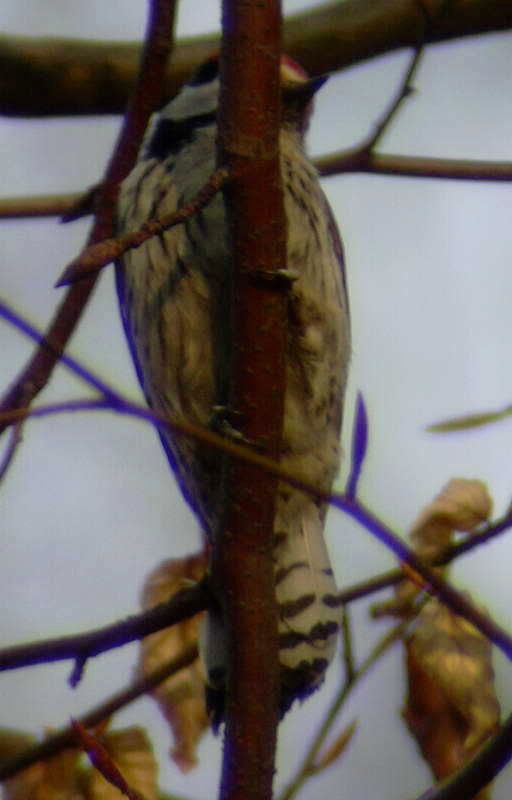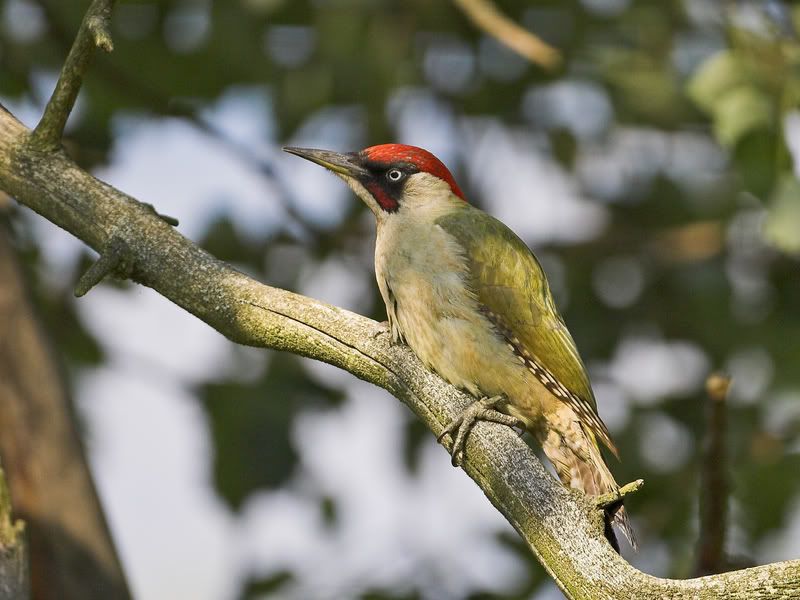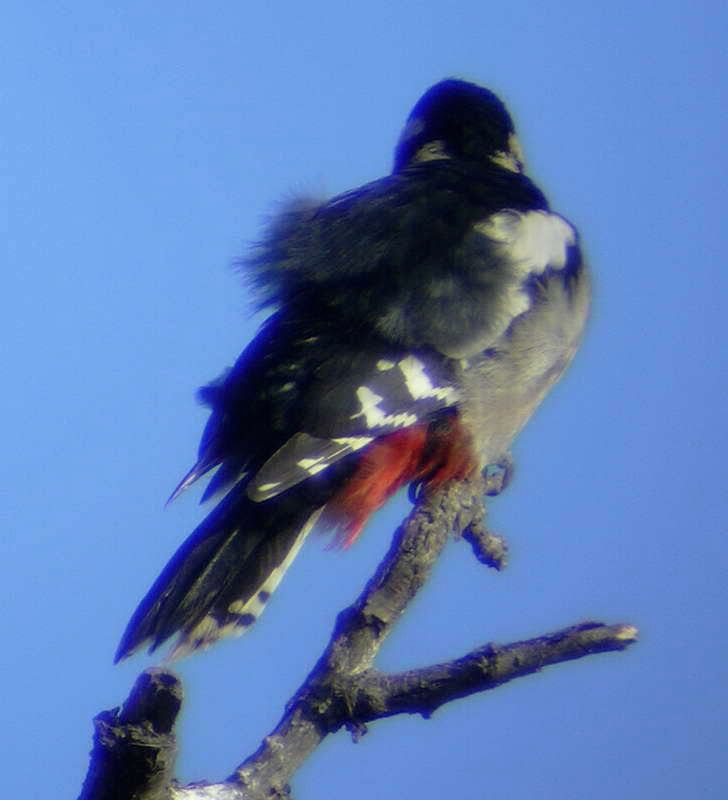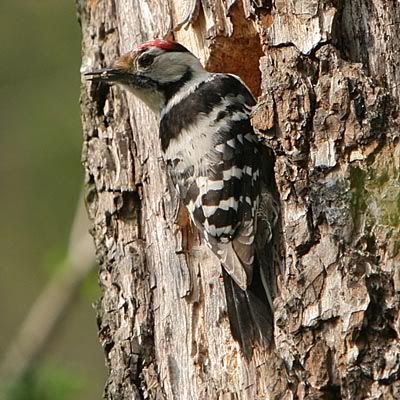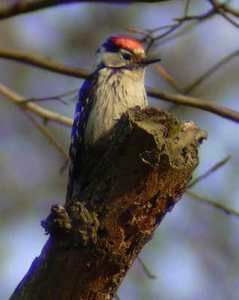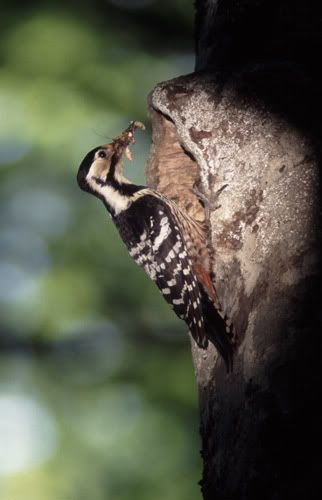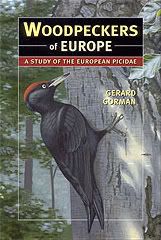 Can you state the species, sex and approximate age of the bird? Everything you need to know to do this is viewable on in photo.
Can you state the species, sex and approximate age of the bird? Everything you need to know to do this is viewable on in photo.
Sunday, 30 September 2007
Quiz Woodpecker 5
 Can you state the species, sex and approximate age of the bird? Everything you need to know to do this is viewable on in photo.
Can you state the species, sex and approximate age of the bird? Everything you need to know to do this is viewable on in photo.
Friday, 28 September 2007
Woodpeckers: juvenile moult
Juvenile woodpeckers begin a partial post juvenile moult at around the time of fledging and this continues until the autumn. In this first moult, juveniles of all ten European woodpecker species replace their primaries, rectrices and overall (body) plumage but some tertials, secondaries, primary coverts and outer greater coverts are retained. One of the ways to age 1st winter birds is the fact that there is often a moult limit in the greater coverts. For example, in Great Spotted Woodpecker where the new adult-type black inner greater coverts, contrast with the old juvenile brownish outer greater coverts. Juveniles have shorter tails than adults, due to all but the central pair of rectrices being shorter than on adults. The odd looking stunted tail of juvenile Black Woodpeckers in flight is due to this tail arrangement. Another interesting case involves Three-toed Woodpecker. Juveniles of this species sometimes begin their moult while still in the nesting cavity. Interestingly, the fifth to seventh innermost primaries are grown and replaced before the birds have fledged and thus they have never been used. This apparent rush to moult is almost certainly an adaptive feature, the result of the need of the species, as a bird of mainly northern latitudes, to complete the moulting task before the end of the short summer season. When the harsh winter season begins birds must be ready to disperse at short notice to new foraging areas, often some distance away, and a delay while moult is completed could prove fatal. For similar reasons, suspended moult occurs in local populations of other species that are prone to eruptive movements such as Fenno-Scandic and Russian Great Spotted Woodpeckers. Juveniles trapped in Fenno-Scandia after arriving from further east in late autumn apparently often exhibit signs of suspended moult in the tail and wing when compared to resident birds. Moult is then resumed sometimes as late as December.
Woodpecker moult
The moult regime of the true woodpeckers is rather unusual and this is related to the lifestyle of the family, in particular to foraging habits and to the breeding cycle. A typical European woodpecker (all except Wryneck) has ten primaries, eleven secondaries, and twelve tail feathers. Primaries 6, 7 and 8 are the longest and P10 is reduced in size in adults but is longer and broader in juveniles. Most adult woodpeckers begin a complete post-breeding moult in late spring or early summer soon after breeding has finished and this lasts into autumn. Primaries are moulted sequentially (ascendant) from P1 and the secondaries from two centres (ascendantly from S1, ascendantly and descendantly from S8). The outermost rectrices are also much shorter than the other tail feathers, the central two being the longest. These two feathers are so important as props when climbing and clinging to vertical surfaces, so they are replaced last, after the other tail feathers. Counting the central two as R1 moult starts ascendantly in pairs from R2 to R6 with R1 last. There is no pre-breeding moult for the true woodpeckers, though Wryneck has a partial pre-breeding moult. Wrynecks moult their tail feathers in reversed sequence.
Wednesday, 26 September 2007
Monday, 24 September 2007
Holes: White-backed Woodpecker - natural hole use
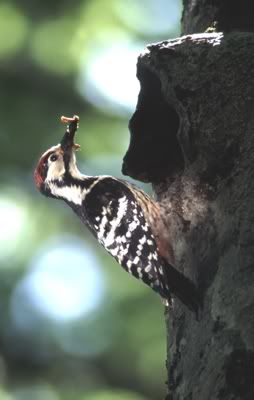 This important photo shows an adult male White-backed Woodpecker (lilfordi race) in the Abruzzo mountains, central Italy (Paul Harris). This is a very interesting shot indeed as it captures the bird using a natural tree hole as a nesting site. It is very rare for a European woodpecker (except Wryneck) to nest in a tree-hole which it did not create itself. Though the entrance is "natural" it is thought that this White-backed pair pair adapted and enlarged the cavity to suit their needs. This breeding site was also successful, note the male has food items in his beak which he is about to offer to the chicks inside the cavity.
This important photo shows an adult male White-backed Woodpecker (lilfordi race) in the Abruzzo mountains, central Italy (Paul Harris). This is a very interesting shot indeed as it captures the bird using a natural tree hole as a nesting site. It is very rare for a European woodpecker (except Wryneck) to nest in a tree-hole which it did not create itself. Though the entrance is "natural" it is thought that this White-backed pair pair adapted and enlarged the cavity to suit their needs. This breeding site was also successful, note the male has food items in his beak which he is about to offer to the chicks inside the cavity.
Holes: White-backed Woodpecker
 This photo shows an adult male White-backed Woodpecker (lilfordi race) in the Abruzzo mountains, central Italy (Paul Harris). Note the almost perfectly round cavity entrance, which is typical for many species including White-backed. The paleness of the exposed wood in the entrance hole indicates the "newness" of the cavity. Indeed, woodpeckers excavate fresh, new nesting holes every spring, though occasionally an old hole will be re-used, presumably after it has proven to be a success, safe nest site. Used cavities often remain clean, as woodpeckers are hygenic breeders removing the droppings of their chicks as they grow, and thus can be re-used (by the woodpeckers who made it or by secondary cavity breeders). White-backed Woodpeckers rarely re-use a hole. This is probably because their holes often do not survive from one spring to the next as they are invariably made in very rotten trees which decay rapidly and become unstable.
This photo shows an adult male White-backed Woodpecker (lilfordi race) in the Abruzzo mountains, central Italy (Paul Harris). Note the almost perfectly round cavity entrance, which is typical for many species including White-backed. The paleness of the exposed wood in the entrance hole indicates the "newness" of the cavity. Indeed, woodpeckers excavate fresh, new nesting holes every spring, though occasionally an old hole will be re-used, presumably after it has proven to be a success, safe nest site. Used cavities often remain clean, as woodpeckers are hygenic breeders removing the droppings of their chicks as they grow, and thus can be re-used (by the woodpeckers who made it or by secondary cavity breeders). White-backed Woodpeckers rarely re-use a hole. This is probably because their holes often do not survive from one spring to the next as they are invariably made in very rotten trees which decay rapidly and become unstable.
Holes: secondary user - Tengmalm's Owl
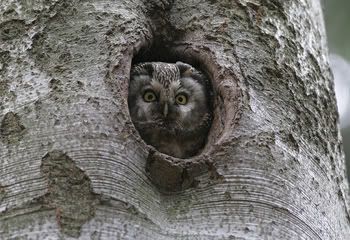 This photo shows a Tengmalm's Owl (Boreal Owl) using an old Black Woodpecker nest-hole in a beech tree as a nesting site. Taken in the Sumava mountains, South Bohemia, Czech Republic, April 2005 (Dave Pullen). This site has been repeatably used for many years by the owls, possibly several generations of the family. The hole is so old that it has been weathered by the elements and the timber "healed". It thus appears almost natural i.e. note the rounded smooth entrance. In 2007 the hole was occupied by wasps and the owls moved on.
This photo shows a Tengmalm's Owl (Boreal Owl) using an old Black Woodpecker nest-hole in a beech tree as a nesting site. Taken in the Sumava mountains, South Bohemia, Czech Republic, April 2005 (Dave Pullen). This site has been repeatably used for many years by the owls, possibly several generations of the family. The hole is so old that it has been weathered by the elements and the timber "healed". It thus appears almost natural i.e. note the rounded smooth entrance. In 2007 the hole was occupied by wasps and the owls moved on.
Holes: Black Woodpecker as a provider
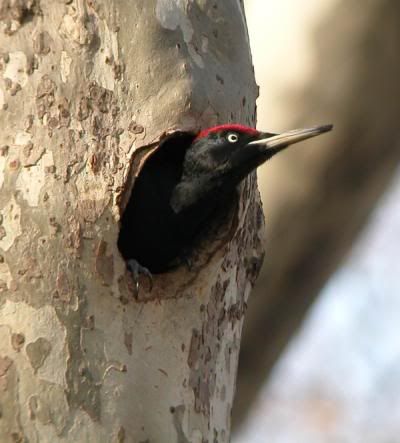 Almost all of Europe’s woodpeckers play a role in providing nest and roost sites for other wildlife. Woodpeckers are primary hole users, that is, they excavate their own holes. Species that do not make their own holes, but rather use those made by others, are known as secondary cavity users. Black Woodpecker is Europe's largest primary excavator. This species can be regarded as a very important species as a provider of tree holes for other animals This is quite simply because this is the only bird in Europe’s forests that can excavate large holes in sound trees. Many species, avian and others, that are unable to do bore into timber use these holes for breeding and roosting. In fact, the distribution and success of these species often depends upon the Black Woodpecker. Birds which commonly use old Black Woodpecker as nest-sites include Stock Dove, Jackdaw and Tengmalm's Owl, whilst mammals include Red Squirrel, Pine Marten and various bats. The photo here shows an adult male Black Woodpecker leaving its hole in a park in Budapest, Hungary (Gábor Vasuta). Note the oval rather than round shape of the entrance which is typical for this species.
Almost all of Europe’s woodpeckers play a role in providing nest and roost sites for other wildlife. Woodpeckers are primary hole users, that is, they excavate their own holes. Species that do not make their own holes, but rather use those made by others, are known as secondary cavity users. Black Woodpecker is Europe's largest primary excavator. This species can be regarded as a very important species as a provider of tree holes for other animals This is quite simply because this is the only bird in Europe’s forests that can excavate large holes in sound trees. Many species, avian and others, that are unable to do bore into timber use these holes for breeding and roosting. In fact, the distribution and success of these species often depends upon the Black Woodpecker. Birds which commonly use old Black Woodpecker as nest-sites include Stock Dove, Jackdaw and Tengmalm's Owl, whilst mammals include Red Squirrel, Pine Marten and various bats. The photo here shows an adult male Black Woodpecker leaving its hole in a park in Budapest, Hungary (Gábor Vasuta). Note the oval rather than round shape of the entrance which is typical for this species.
Saturday, 22 September 2007
Holes: location
 Holes are generally placed as high as possible and two factors probably contribute to this. Firstly, a high location means more protection from general disturbance and predators. Secondly, wood is newer and hence softer in higher sections of trunk than it is lower down and thus excavation is easier. When a pair of woodpeckers nest at low levels, in stumps for example, it is probably because of a lack of suitable high locations. The softest parts of a tree are usually chosen, though the outer layers of the tree must be strong and rigid enough to support the cavity. Thus, the perfect location will combine a hard outer protective shell and a soft, rotten core that can be easily excavated. And another trade-off exists: the hardness of wood decreases as trees die thus live trees may provide a sound shell but are harder to excavate, whilst rotten trees are easier to excavate but may not provide a strong enough outer structure to support a cavity. Strong winds snap trees off at the weakest point and this is often the spot where a woodpecker cavity has been excavated. It is unclear how woodpeckers identify suitable nesting trees, that is, how they know which trees contain soft heartwood. It is probable that a combination of visual clues, such as fungal growths and already existing holes and the sounding out of wood with taps are combined. Whenever possible soft tree species like pine and aspen are used. Despite the formidable chisel-like bill that woodpeckers have, they seemingly do not like to do more excavating than is necessary. In hilly landscapes Europe’s woodpeckers usually excavate their nests on south-facing slopes. Holes in trees situated in open areas are more likely to be placed on the north facing side than those inside woodland. It has been suggested that this is to minimize overheating by the sun. Besides compass direction, other factors influence the location of holes on trees. A very important factor seems to be height. In my experience, when a nest tree is on a slope, holes placed in it will face away from the slope, regardless of compass direction. This may be because a hole facing downhill will always be higher than one on the opposite side of the trunk facing uphill and this offers better protection from predators. Indeed, I have never found a woodpecker hole of any species where the entrance faced uphill or inclined upwards. It has also been suggested that the reason why holes usually face outwards from slopes is because of a need for a "good lookout". This idea, too, is linked to the need to reduce risks from predators, which can be seen more easily and earlier. This photo of a juvenile Great Spotted Woodpecker was taken in England (Bill Baston). This is a rather worn entrance hole, and does not seem as tight a fit as is usual for woodpecker nest-hole entrances. Perhaps the rather rugged bark, and angle of the trunk made creating a close-fit difficult?
Holes are generally placed as high as possible and two factors probably contribute to this. Firstly, a high location means more protection from general disturbance and predators. Secondly, wood is newer and hence softer in higher sections of trunk than it is lower down and thus excavation is easier. When a pair of woodpeckers nest at low levels, in stumps for example, it is probably because of a lack of suitable high locations. The softest parts of a tree are usually chosen, though the outer layers of the tree must be strong and rigid enough to support the cavity. Thus, the perfect location will combine a hard outer protective shell and a soft, rotten core that can be easily excavated. And another trade-off exists: the hardness of wood decreases as trees die thus live trees may provide a sound shell but are harder to excavate, whilst rotten trees are easier to excavate but may not provide a strong enough outer structure to support a cavity. Strong winds snap trees off at the weakest point and this is often the spot where a woodpecker cavity has been excavated. It is unclear how woodpeckers identify suitable nesting trees, that is, how they know which trees contain soft heartwood. It is probable that a combination of visual clues, such as fungal growths and already existing holes and the sounding out of wood with taps are combined. Whenever possible soft tree species like pine and aspen are used. Despite the formidable chisel-like bill that woodpeckers have, they seemingly do not like to do more excavating than is necessary. In hilly landscapes Europe’s woodpeckers usually excavate their nests on south-facing slopes. Holes in trees situated in open areas are more likely to be placed on the north facing side than those inside woodland. It has been suggested that this is to minimize overheating by the sun. Besides compass direction, other factors influence the location of holes on trees. A very important factor seems to be height. In my experience, when a nest tree is on a slope, holes placed in it will face away from the slope, regardless of compass direction. This may be because a hole facing downhill will always be higher than one on the opposite side of the trunk facing uphill and this offers better protection from predators. Indeed, I have never found a woodpecker hole of any species where the entrance faced uphill or inclined upwards. It has also been suggested that the reason why holes usually face outwards from slopes is because of a need for a "good lookout". This idea, too, is linked to the need to reduce risks from predators, which can be seen more easily and earlier. This photo of a juvenile Great Spotted Woodpecker was taken in England (Bill Baston). This is a rather worn entrance hole, and does not seem as tight a fit as is usual for woodpecker nest-hole entrances. Perhaps the rather rugged bark, and angle of the trunk made creating a close-fit difficult?
Holes: used and unused
 The main period of hole excavating activity is in early spring, in the lead up to breeding. But this is not the only time of year when such work is done. After the chicks have fledged most adults begin to excavate more holes in the home range. These, and used nest holes, serve as roosts through the autumn and winter. Depending on the species it takes up to four weeks for a new hole and chamber to be completed, though in most cases two weeks is enough. Black and Great Spotted Woodpeckers will excavate holes in live trees, the other European woodpecker species rarely do so. Black Woodpecker is the only species that can excavate cavities in the sound, living wood of trees. All other species need either dead trees with rotten wood or live trees with heart rot. For all woodpeckers the quality and condition of wood is more important than tree species. Whether good excavators or not all species seem to depend upon the heart of the tree or core of the branch being softer than the surface. Many trees which are sound on the outside may be soft at the core due to fungi such as heart-rot and/or invertebrate activity. Much of the general tapping that woodpeckers do may be a "sounding out" technique where such wood suitable for excavation is discovered. It seems that creating a complete hole (entrance, tunnel and chamber) in completely sound wood seems to be just too much for even the best excavators. It is therefore common for a bird to abandon a site soon after starting work, probably when the bird realises that the timber chosen is hard to the core. It is not unusual for woodpecker-rich woodlands to be full of many apparent holes, which upon inspection prove to be just a few inches deep, merely entrances rather than chambers. The photo here of an adult male Lesser Spotted Woodpecker excavating a nest-hole, was taken in Chemnitz, Germany (Thomas Kraft). Wood-chips can be seen flying off the tree as the bird works. Note too, how the bird's tail is pressed against the trunk and thus acts as a stable prop.
The main period of hole excavating activity is in early spring, in the lead up to breeding. But this is not the only time of year when such work is done. After the chicks have fledged most adults begin to excavate more holes in the home range. These, and used nest holes, serve as roosts through the autumn and winter. Depending on the species it takes up to four weeks for a new hole and chamber to be completed, though in most cases two weeks is enough. Black and Great Spotted Woodpeckers will excavate holes in live trees, the other European woodpecker species rarely do so. Black Woodpecker is the only species that can excavate cavities in the sound, living wood of trees. All other species need either dead trees with rotten wood or live trees with heart rot. For all woodpeckers the quality and condition of wood is more important than tree species. Whether good excavators or not all species seem to depend upon the heart of the tree or core of the branch being softer than the surface. Many trees which are sound on the outside may be soft at the core due to fungi such as heart-rot and/or invertebrate activity. Much of the general tapping that woodpeckers do may be a "sounding out" technique where such wood suitable for excavation is discovered. It seems that creating a complete hole (entrance, tunnel and chamber) in completely sound wood seems to be just too much for even the best excavators. It is therefore common for a bird to abandon a site soon after starting work, probably when the bird realises that the timber chosen is hard to the core. It is not unusual for woodpecker-rich woodlands to be full of many apparent holes, which upon inspection prove to be just a few inches deep, merely entrances rather than chambers. The photo here of an adult male Lesser Spotted Woodpecker excavating a nest-hole, was taken in Chemnitz, Germany (Thomas Kraft). Wood-chips can be seen flying off the tree as the bird works. Note too, how the bird's tail is pressed against the trunk and thus acts as a stable prop.
Holes: safety
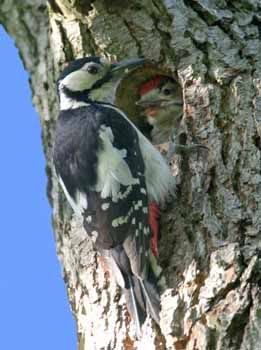 The photo here is of adult female Great Spotted Woodpecker feeding a well grown, and ready to fledge, juvenile at a nest-hole in England (Bill Baston). On this view the advantage of being raised in a cavity rather than in an open nest can be imagined: shelter from the elements and safety from most predators.
The photo here is of adult female Great Spotted Woodpecker feeding a well grown, and ready to fledge, juvenile at a nest-hole in England (Bill Baston). On this view the advantage of being raised in a cavity rather than in an open nest can be imagined: shelter from the elements and safety from most predators..
Friday, 21 September 2007
Holes
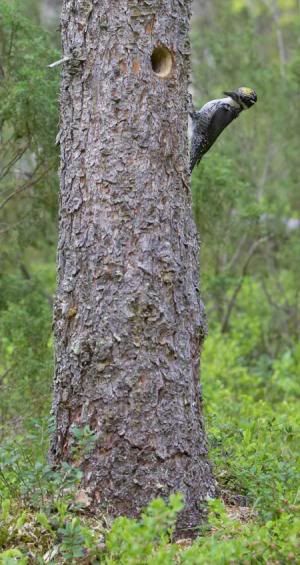 The ability that woodpeckers have of being able to excavate holes in trees is the one thing that really sets them apart from other birds. In Europe woodpeckers are primary hole-excavators, that is, they are the bird family that contributes most to the process of cavity making in forests. To be it simply THEY excavate their own holes, for breeding in and roosting in. The fact that woodpeckers can do this is one of the main reasons why they are successful. There are many advantages for both parents and chicks in being able to raise and be raised in the weatherproof haven of a chamber inside a tree. Being able to roost in such shelters is obviously an advantage for adults, too. This photo from Finland (Jari Peltomaki) shows a mlae Three-toed Woodpecker at the nest-hole. Note how the entrance hole is almost perfectly round. The hole is around one metre above ground level. Such a height is not unusual for this species though most other woodpecker species rarely nest this low. With experience many nest-holes (though not all) can be assigned to species without the bird beeing seen. When searching for woodpecker holes it should be kept in mind that it is the quality of the wood, rather than tree species, that dictates the chosen site, though some tree species are obviously preferred over others. In areas of Europe where several woodpecker species are sympatric this can mean six or even more species co-existing, and the forest riddled with various holes of differing sizes and shapes. I will discuss this further in subsequent posts.
The ability that woodpeckers have of being able to excavate holes in trees is the one thing that really sets them apart from other birds. In Europe woodpeckers are primary hole-excavators, that is, they are the bird family that contributes most to the process of cavity making in forests. To be it simply THEY excavate their own holes, for breeding in and roosting in. The fact that woodpeckers can do this is one of the main reasons why they are successful. There are many advantages for both parents and chicks in being able to raise and be raised in the weatherproof haven of a chamber inside a tree. Being able to roost in such shelters is obviously an advantage for adults, too. This photo from Finland (Jari Peltomaki) shows a mlae Three-toed Woodpecker at the nest-hole. Note how the entrance hole is almost perfectly round. The hole is around one metre above ground level. Such a height is not unusual for this species though most other woodpecker species rarely nest this low. With experience many nest-holes (though not all) can be assigned to species without the bird beeing seen. When searching for woodpecker holes it should be kept in mind that it is the quality of the wood, rather than tree species, that dictates the chosen site, though some tree species are obviously preferred over others. In areas of Europe where several woodpecker species are sympatric this can mean six or even more species co-existing, and the forest riddled with various holes of differing sizes and shapes. I will discuss this further in subsequent posts.
Green Woodpecker: photo of male
Thursday, 20 September 2007
Quiz Woodpecker 2
Wednesday, 19 September 2007
Lesser Spotted Woodpecker: adult male photo
Lesser Spotted Woodpecker: races ID
 There are clinal differences in the plumage and measurements of Lesser Spotted Woodpecker across its range. There are often clear differences between races in terms of size, pattern of plumage and colour tones, in particular the shade of white on the head. As a rule northern and eastern birds are paler and larger than southern and western ones. In Europe three groups can be defined in the hand. The nominate minor (Scandinavia to Urals) is the largest, longest tailed, longest winged and is overall whiter with less streaking on the flanks and less bars on the outer tail. Hortorum (most of continental Europe) is intermediate in wing length, is slightly smaller, with a slightly shorter tail. This race also has less white on the back, has darker and buffer under-parts, more flank streaking and the outer rectrices are more barred than on minor, the face appears dirty and some show a touch of pink on the throat and upper breast. Buturlini (Iberia, through Mediterranean zone to the Balkans), danfordi (Greece and Turkey) and comminutus (Britain) are darker and all short in the wing. On most danfordi birds the black post-auricular stripe comes close to, or even touches the nape. Most comminutus are largely plain white, lacking streaks below. This photo shows a nominate race (minor) adult male (note red on crown) in Sweden, in February 2005 (Göran Ekström). Note how the white underparts lack barring. Note also just two clear black bars on the outer tail feather.
There are clinal differences in the plumage and measurements of Lesser Spotted Woodpecker across its range. There are often clear differences between races in terms of size, pattern of plumage and colour tones, in particular the shade of white on the head. As a rule northern and eastern birds are paler and larger than southern and western ones. In Europe three groups can be defined in the hand. The nominate minor (Scandinavia to Urals) is the largest, longest tailed, longest winged and is overall whiter with less streaking on the flanks and less bars on the outer tail. Hortorum (most of continental Europe) is intermediate in wing length, is slightly smaller, with a slightly shorter tail. This race also has less white on the back, has darker and buffer under-parts, more flank streaking and the outer rectrices are more barred than on minor, the face appears dirty and some show a touch of pink on the throat and upper breast. Buturlini (Iberia, through Mediterranean zone to the Balkans), danfordi (Greece and Turkey) and comminutus (Britain) are darker and all short in the wing. On most danfordi birds the black post-auricular stripe comes close to, or even touches the nape. Most comminutus are largely plain white, lacking streaks below. This photo shows a nominate race (minor) adult male (note red on crown) in Sweden, in February 2005 (Göran Ekström). Note how the white underparts lack barring. Note also just two clear black bars on the outer tail feather.
Lesser Spotted Woodpecker: juvenile ID
 Juvenile Lesser Spotted Woodpeckers are overall duller than adults. Black areas are less glossy, rather matt, and often with a tinge of brown. The breast and flanks are a dirty white, sometimes quite dusky, with more streaks than adults, though such streaks are finer and weaker than on adults. The base of the lower mandible is often paler than on adults, too. The iris is a dull brown. Juvenile males have a pinkish/reddish fore-crown flecked with grey or black feather tips. By late summer more red on crown is evident .Juvenile femaleshave a pale fore-crown mottled with black or grey feather tips. This patch is smaller than on adult females. The fore-crown is pale or buff, with some dark grey feather tips. Some birds may have a touch of reddish feathering on the fore-crown, though this is usually negligible and if present disappears after the first moult. The photo here is of a juvenile male in a ringing camp in Estonia (Uku Paal).
Juvenile Lesser Spotted Woodpeckers are overall duller than adults. Black areas are less glossy, rather matt, and often with a tinge of brown. The breast and flanks are a dirty white, sometimes quite dusky, with more streaks than adults, though such streaks are finer and weaker than on adults. The base of the lower mandible is often paler than on adults, too. The iris is a dull brown. Juvenile males have a pinkish/reddish fore-crown flecked with grey or black feather tips. By late summer more red on crown is evident .Juvenile femaleshave a pale fore-crown mottled with black or grey feather tips. This patch is smaller than on adult females. The fore-crown is pale or buff, with some dark grey feather tips. Some birds may have a touch of reddish feathering on the fore-crown, though this is usually negligible and if present disappears after the first moult. The photo here is of a juvenile male in a ringing camp in Estonia (Uku Paal).
Lesser Spotted Woodpecker: adult female ID
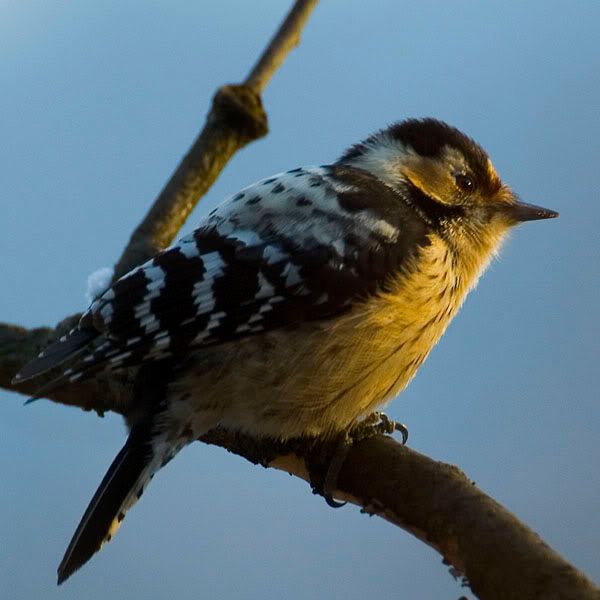 Adult female Lesser Spotted Woodpeckers are completely pied. That is, they are black and white. Thus they mainly differ from males in lacking red on the crown. However, a few females may show a tinge of pink at the rear of the crown and some may have faint red feather tips, but these are rarely visible in the field, only on birds in the hand. They have a buff forehead, dirty white fore-crown and black hind-crown. Some may have a brownish crown edged with black. Typical females have a white fore-crown edged with black that extends over the eye. Females have longer wings and longer tails than males but this is minimal and not noticeable in the field. This photo shows an adult female in Hungary (László Nehézy). Note the completely lack of any red.
Adult female Lesser Spotted Woodpeckers are completely pied. That is, they are black and white. Thus they mainly differ from males in lacking red on the crown. However, a few females may show a tinge of pink at the rear of the crown and some may have faint red feather tips, but these are rarely visible in the field, only on birds in the hand. They have a buff forehead, dirty white fore-crown and black hind-crown. Some may have a brownish crown edged with black. Typical females have a white fore-crown edged with black that extends over the eye. Females have longer wings and longer tails than males but this is minimal and not noticeable in the field. This photo shows an adult female in Hungary (László Nehézy). Note the completely lack of any red.
Lesser Spotted Woodpecker: adult male ID
Lesser Spotted Woodpecker: general ID
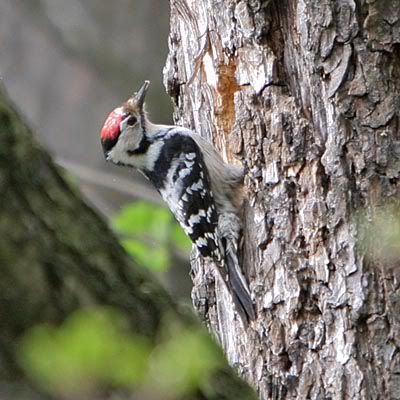 Measurements: Length 14-16 cm. Wingspan 24-27 cm. Europe’s smallest woodpecker is just two-thirds the size of Great Spotted and Syrian Woodpeckers and around three-quarters the size of Middle Spotted Woodpecker. This species appears short-tailed and round headed in shape. It is the only European Dendrocopos woodpecker to lack red or pink colouration on the under-tail coverts and ventral area, which are white, spotted with grey-black. It is also "ladder-backed", lacking the white oval scapular patches of most other Dendrocopos woodpeckers. In fact, in terms of the black-and-white back pattern, Lesser Spotted most resembles White-backed Woodpecker. Black lower mantle, scapulars and upper rump barred white. Breast and belly whitish, with a suggestion of buff. White flanks and sides of breast generally finely streaked with black, but never to the extent of Middle Spotted Woodpecker. The black tips of the greater and some median wing-coverts are spotted white. Black flight feathers barred boldly white. Upper tail black, outer rectrices white with 2-3 black bars before tips. Sides of face, ear-coverts, chin and throat white. Black malar stripe runs from base of lower mandible to side of neck where it joins black lateral neck stripe and post-auricular stripe. A large black area is formed at this T-junction. The lateral neck stripe runs down onto the side of the breast. On the vast majority of birds the post-auricular stripe reaches only halfway or so across the ear-coverts and does not touch the black nape (this varies with race). Thus the reddish-brown eye (iris) is set in a large, open area of white. The bill is mostly grey-charcoal, with the base of the lower mandible paler, often lead coloured. It appears slight, pointed and rather weak. However, 12-18 mm long, it is in fact relatively large for the overall size of the bird. The legs are greyish-green. The photo shows an adult male at Chemnitz, Germany (Thomas Kraft).
Measurements: Length 14-16 cm. Wingspan 24-27 cm. Europe’s smallest woodpecker is just two-thirds the size of Great Spotted and Syrian Woodpeckers and around three-quarters the size of Middle Spotted Woodpecker. This species appears short-tailed and round headed in shape. It is the only European Dendrocopos woodpecker to lack red or pink colouration on the under-tail coverts and ventral area, which are white, spotted with grey-black. It is also "ladder-backed", lacking the white oval scapular patches of most other Dendrocopos woodpeckers. In fact, in terms of the black-and-white back pattern, Lesser Spotted most resembles White-backed Woodpecker. Black lower mantle, scapulars and upper rump barred white. Breast and belly whitish, with a suggestion of buff. White flanks and sides of breast generally finely streaked with black, but never to the extent of Middle Spotted Woodpecker. The black tips of the greater and some median wing-coverts are spotted white. Black flight feathers barred boldly white. Upper tail black, outer rectrices white with 2-3 black bars before tips. Sides of face, ear-coverts, chin and throat white. Black malar stripe runs from base of lower mandible to side of neck where it joins black lateral neck stripe and post-auricular stripe. A large black area is formed at this T-junction. The lateral neck stripe runs down onto the side of the breast. On the vast majority of birds the post-auricular stripe reaches only halfway or so across the ear-coverts and does not touch the black nape (this varies with race). Thus the reddish-brown eye (iris) is set in a large, open area of white. The bill is mostly grey-charcoal, with the base of the lower mandible paler, often lead coloured. It appears slight, pointed and rather weak. However, 12-18 mm long, it is in fact relatively large for the overall size of the bird. The legs are greyish-green. The photo shows an adult male at Chemnitz, Germany (Thomas Kraft).Tuesday, 18 September 2007
Quiz Woodpecker 1
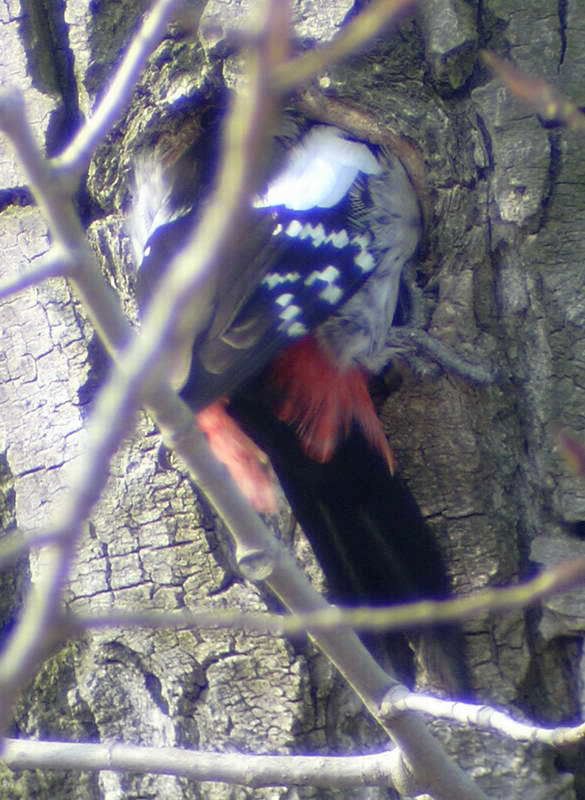 From time to time I will post a photo of a so-called "quiz bird", of course, always a woodpecker. This will allow you all to test your ID skills on a family of birds that, on the face of it, is not that difficult to ID, but which in the field (the woods) often only offer brief glimpses, take up unusual poses or are obscured by vegetation. The first in this series is here on the left. The ID sections in this blog should be enough to facilitate a correct ID. Good luck. And do let me know your answer.
From time to time I will post a photo of a so-called "quiz bird", of course, always a woodpecker. This will allow you all to test your ID skills on a family of birds that, on the face of it, is not that difficult to ID, but which in the field (the woods) often only offer brief glimpses, take up unusual poses or are obscured by vegetation. The first in this series is here on the left. The ID sections in this blog should be enough to facilitate a correct ID. Good luck. And do let me know your answer.
Friday, 14 September 2007
White-backed Woodpecker: juvenile lilfordi race ID
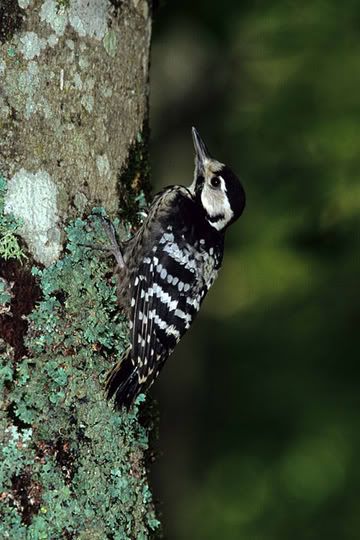 As is the case with the nominate leucotos, juveniles of the lilfordi race are not as glossy as adults, indeed they are sometimes rather brownish. Again, as with the nominate leucotos, they are sexually dimorphic from an early age, even when in the nest. White areas are dirtier, buffier than on adults. The pink under-tail and ventral region is smaller and paler than on adults and they are very heavily streaked on the body. Both sexes have red crowns (to varying extents) but this red is never as strong as on adults, being sometimes rather orange, edged with black and sometimes flecked with grey-black feather tips. Juvenile male lilfordi has a complete red crown that may extend to the black nape and sideways to the white cheeks. Males are longer billed and legged than sibling females but this only noticeable in the hand. Juvenile female lilfordi usually lack red on the crown. If any is present, then it is only on the fore-crown to central crown. There is always less red than on juvenile males. Sometimes just a few red tips to the black feathers can be seen. This photo is of a juvenile female lilfordi, in the Abruzzi Mountains, central Italy (Paul Harris).
As is the case with the nominate leucotos, juveniles of the lilfordi race are not as glossy as adults, indeed they are sometimes rather brownish. Again, as with the nominate leucotos, they are sexually dimorphic from an early age, even when in the nest. White areas are dirtier, buffier than on adults. The pink under-tail and ventral region is smaller and paler than on adults and they are very heavily streaked on the body. Both sexes have red crowns (to varying extents) but this red is never as strong as on adults, being sometimes rather orange, edged with black and sometimes flecked with grey-black feather tips. Juvenile male lilfordi has a complete red crown that may extend to the black nape and sideways to the white cheeks. Males are longer billed and legged than sibling females but this only noticeable in the hand. Juvenile female lilfordi usually lack red on the crown. If any is present, then it is only on the fore-crown to central crown. There is always less red than on juvenile males. Sometimes just a few red tips to the black feathers can be seen. This photo is of a juvenile female lilfordi, in the Abruzzi Mountains, central Italy (Paul Harris).
White-backed Woodpecker: female lilfordi race ID
White-backed Woodpecker: male lilfordi race ID
White-backed Woodpecker: lilfordi race general ID
The general features described elsewhere in this blog for nominate leucotos apply equally to the southern European race lilfordi. However, there are some striking and important differences in plumage that together with wing and bill measurements, voice, habitat selection and distribution, have resulted in this race sometimes being considered a separate species i.e. Lilford’s Woodpecker. Lilfordi is slightly larger, overall darker and more heavily streaked with long, black, flecks on the flanks, breast and belly. In addition to vertical streaks there are also some horizontal bars on the flanks that nominate lacks. The pink ventral area extends further up onto the belly than leucotos, often onto the lower breast. Under-parts various shades of white, cream, often dusky or tinged buff and always more marked and darker than leucotos. The forehead, lores, cheeks and throat are also more yellow. The black post-auricular stripe and malar stripe are broader and, where they join to form a T-junction, below the ear-coverts, a larger black area is formed. Face patterns may vary slightly from bird to bird but on all the post-auricular stripe runs over the ear-coverts and finishes much closer to, or even touches, the nape. On leucotos it never touches the nape and a wider white gap is clear. Wings have narrower white bars than on nominate. But above all lilfordi lacks the clear white lower-back and upper rump patch of leucotos race. Lilfordi is thus less "white-backed" than leucotos. It is rather "barred-backed" or perhaps "ladder-backed" due to the white-back and upper-rump being vermiculated with black. The rump of this race often seems totally black.
White-backed Woodpecker: juvenile female ID
Juvenile female White-backeds have red colouration only on the fore-crown (adult female has none) but this often rather patchy, and always less than on juvenile male. Sometimes this patch is merely a few red or pink feathers. The true extent of red on the crown becomes evident some twelve days after hatching.
White-backed Woodpecker: juvenile male ID
Juvenile male White-backeds have an all red crown which extends at the back of the head to the black nape and sideways to the white cheeks. This becomes apparent around twelve days after hatching and is more pronounced as birds peep out of the hole prior to fledging. Male fledglings are generally heavier, and have longer bills and tarsi than sibling females though these factors only noticeable in the hand.
White-backed Woodpecker: juvenile ID
 Juvenile White-backed Woodpeckers are sexually dimorphic whilst still in the nest. It takes around seven months (i.e. into the winter following fledging) for juveniles to attain full adult plumage. Juveniles are duller and browner than adults and black areas matt rather than glossy. White areas are greyer, dirtier than on adult and there is often a grey smudge over the ear-coverts and behind eye (similar to that on juvenile Syrian Woodpecker). The pink ventral region is smaller and paler than on adults and the dark streaks on the under-body are more diffuse. Both male and female juveniles have red on the crown (see other posts) but they are not as strong in colour as on adult males. The red crown is sometimes rather rusty and with grey or black flecks. Bare parts are grey. The photo here shows a fledging female at Varmland, Sweden, taken in May 1994 (Göran Ekström). Note that there is only a hint of pink on the forecrown on this bird.
Juvenile White-backed Woodpeckers are sexually dimorphic whilst still in the nest. It takes around seven months (i.e. into the winter following fledging) for juveniles to attain full adult plumage. Juveniles are duller and browner than adults and black areas matt rather than glossy. White areas are greyer, dirtier than on adult and there is often a grey smudge over the ear-coverts and behind eye (similar to that on juvenile Syrian Woodpecker). The pink ventral region is smaller and paler than on adults and the dark streaks on the under-body are more diffuse. Both male and female juveniles have red on the crown (see other posts) but they are not as strong in colour as on adult males. The red crown is sometimes rather rusty and with grey or black flecks. Bare parts are grey. The photo here shows a fledging female at Varmland, Sweden, taken in May 1994 (Göran Ekström). Note that there is only a hint of pink on the forecrown on this bird.
White-backed Woodpecker: adult female ID
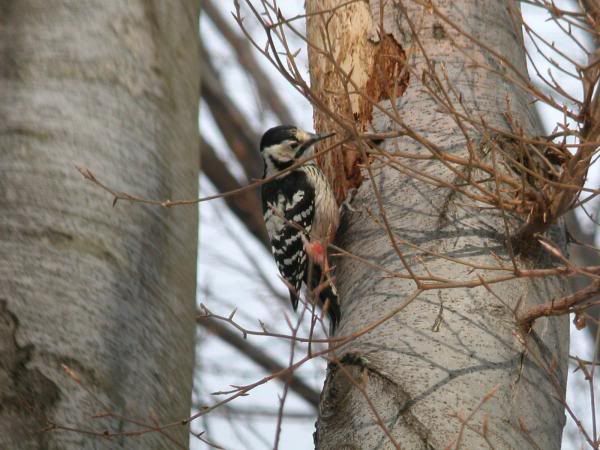 Adult female White-backed Woodpeckers lack the red crown of males. The complete crown from forehead to nape is black. Overall females are slightly smaller than males and their bill is slightly shorter, but these features are not really noticeable in the field. This photo of an adult female leucotos was taken in the Bakony Hills, Hungary (Gábor Vasuta).
Adult female White-backed Woodpeckers lack the red crown of males. The complete crown from forehead to nape is black. Overall females are slightly smaller than males and their bill is slightly shorter, but these features are not really noticeable in the field. This photo of an adult female leucotos was taken in the Bakony Hills, Hungary (Gábor Vasuta).
White-backed Woodpecker: adult male ID
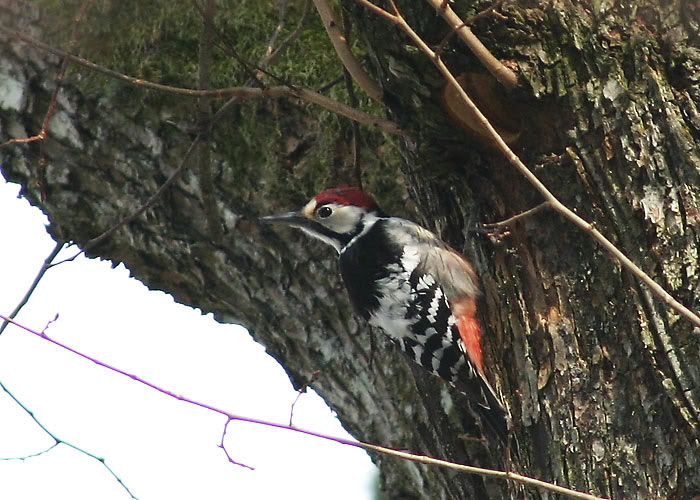 As is the case (though to varying degrees) with other "pied" woodpeckers in Europe, White-backed males are slightly heavier, bigger and have longer bills than females. Bill length is the most significant morphological feature in terms of sexual dimorphism, but is not rarely noticeable in the field and only when a pair is seen together. The all red crown is the main feature distinguishing males from females (which lack red on the head). Sometimes these red feathers have visible dark bases. On some males the pink of the under-tail coverts and vental area reaches as far as the lower belly, lower flanks and leg feathering. On females it is usually less extensive, though this is variable. The photo here is of an adult male leucotos in Estonia, taken on 2.4.2005 (Uku Paal).
As is the case (though to varying degrees) with other "pied" woodpeckers in Europe, White-backed males are slightly heavier, bigger and have longer bills than females. Bill length is the most significant morphological feature in terms of sexual dimorphism, but is not rarely noticeable in the field and only when a pair is seen together. The all red crown is the main feature distinguishing males from females (which lack red on the head). Sometimes these red feathers have visible dark bases. On some males the pink of the under-tail coverts and vental area reaches as far as the lower belly, lower flanks and leg feathering. On females it is usually less extensive, though this is variable. The photo here is of an adult male leucotos in Estonia, taken on 2.4.2005 (Uku Paal).
White-backed Woodpecker: general ID
 Measurements: Length 24-26 cm. Wingspan 38-40 cm, hence the largest Dendrocopos woodpecker in Europe, some 2-3 cm longer than Great Spotted and Syrian Woodpeckers. White-backed is not a difficult woodpecker to identify once found, usually immediately appearing to be rather long-necked and long-billed. The nominate leucotos race is described here (lilfordi in another post). Birds do indeed have a white upper-rump and lower-back but they are not as “white-backed" as their name suggests. The upper back is glossy black and the white on the back below this is sometimes obscured and difficult to see. Rather, it is the white barred coverts, particularly the upper broad white bar of the median coverts that are seen. When a bird takes flight the large white area composed of the lower scapulars, lower back and upper rump comes into view. In most cases this white area is crescent-shaped and connects with the uppermost wing bars. However, on some birds this white area is only slightly broader than the white upper-wing bars. The amount of white on the lower back also varies. There can also be significant variation between birds in the shape and extent of their white back. Individual plumage variations can sometimes exist between populations and sometimes within them. The wings are black but dotted with white on the greater coverts. The flight feathers are crossed by rows of large white spots that almost form bars. White bars on the upper-wing, are often obscured by the white back patch, which sometimes forms a broad fringe across the back. The broad white bar on the upper-wing is striking when in flight and on perching birds seen from side. On a rear view heavy white barring can be seen to extend across the closed tertials (unlike Great Spotted and Syrian). The scapulars are glossy black. The upper-tail coverts and most of the rectrices are black. The outer rectrices are white with thin black barring. The ventral region and under-tail coverts are pink, never red, and not strongly demarcated from the whitish belly (as Great Spotted). The pink extends up and merges into the lower belly and sometimes colours the flanks and leg feathering (as Middle Spotted). Under-parts are white or cream, but often with a yellowish hue. Long black streaks cover the flanks, and sides of the breast and belly (as Middle Spotted). Despite having pink and yellow areas on the under-parts, White-backed Woodpecker always shows much white in flight. The face pattern can vary slightly from bird to bird but typically the black malar stripe starts from the lower mandible (unlike Middle Spotted) and meets the post-auricular stripe on the side of the neck to form a black T-junction. From here a black stripe runs down to the sides of the neck and onto the upper breast, and below this the black flank streaking is strongest. The post-auricular stripe runs over and across the ear-coverts towards the nape, but not touching it (like Syrian and Middle Spotted but unlike Great Spotted). Face, chin and throat are all white but buff behind the eye. On a rear view a black linking stripe from black nape down to glossy black mantle can be seen (recalling Middle Spotted). The forehead and lores are greyish. The bill is grey, long and very thin at the tip, the iris reddish brown and the legs and toes grey. The photo here is of an adult male leucotos race, taken in the Bükk Hills, Hungary (László Nehézy).
Measurements: Length 24-26 cm. Wingspan 38-40 cm, hence the largest Dendrocopos woodpecker in Europe, some 2-3 cm longer than Great Spotted and Syrian Woodpeckers. White-backed is not a difficult woodpecker to identify once found, usually immediately appearing to be rather long-necked and long-billed. The nominate leucotos race is described here (lilfordi in another post). Birds do indeed have a white upper-rump and lower-back but they are not as “white-backed" as their name suggests. The upper back is glossy black and the white on the back below this is sometimes obscured and difficult to see. Rather, it is the white barred coverts, particularly the upper broad white bar of the median coverts that are seen. When a bird takes flight the large white area composed of the lower scapulars, lower back and upper rump comes into view. In most cases this white area is crescent-shaped and connects with the uppermost wing bars. However, on some birds this white area is only slightly broader than the white upper-wing bars. The amount of white on the lower back also varies. There can also be significant variation between birds in the shape and extent of their white back. Individual plumage variations can sometimes exist between populations and sometimes within them. The wings are black but dotted with white on the greater coverts. The flight feathers are crossed by rows of large white spots that almost form bars. White bars on the upper-wing, are often obscured by the white back patch, which sometimes forms a broad fringe across the back. The broad white bar on the upper-wing is striking when in flight and on perching birds seen from side. On a rear view heavy white barring can be seen to extend across the closed tertials (unlike Great Spotted and Syrian). The scapulars are glossy black. The upper-tail coverts and most of the rectrices are black. The outer rectrices are white with thin black barring. The ventral region and under-tail coverts are pink, never red, and not strongly demarcated from the whitish belly (as Great Spotted). The pink extends up and merges into the lower belly and sometimes colours the flanks and leg feathering (as Middle Spotted). Under-parts are white or cream, but often with a yellowish hue. Long black streaks cover the flanks, and sides of the breast and belly (as Middle Spotted). Despite having pink and yellow areas on the under-parts, White-backed Woodpecker always shows much white in flight. The face pattern can vary slightly from bird to bird but typically the black malar stripe starts from the lower mandible (unlike Middle Spotted) and meets the post-auricular stripe on the side of the neck to form a black T-junction. From here a black stripe runs down to the sides of the neck and onto the upper breast, and below this the black flank streaking is strongest. The post-auricular stripe runs over and across the ear-coverts towards the nape, but not touching it (like Syrian and Middle Spotted but unlike Great Spotted). Face, chin and throat are all white but buff behind the eye. On a rear view a black linking stripe from black nape down to glossy black mantle can be seen (recalling Middle Spotted). The forehead and lores are greyish. The bill is grey, long and very thin at the tip, the iris reddish brown and the legs and toes grey. The photo here is of an adult male leucotos race, taken in the Bükk Hills, Hungary (László Nehézy).
Middle Spotted Woodpecker: races ID
The nominate race, medius, occurs in Europe though birds on the Greek island of Lesvos may belong to the anatoliae race which breeds on the nearby Turkish mainland. Anatoliae is slightly smaller and more heavily marked on the flanks and breast than medius. But generally differences in size and colour are clinal. As a rule populations in northern and central Europe are larger and paler than in the Balkans and Mediterranean zone.
Middle Spotted Woodpecker: juvenile ID
Black areas of plumage on juvenile Middle Spotted Woodpeckers are less glossy than on adults. Recently fledged birds have brownish greater wing coverts whereas adults have totally black greater wing coverts. White areas of wing-coverts and scapulars have brownish marks. White upper-parts are buffer with some brownish feather tips. White under-parts are greyish rather than yellowish. White on face smudged with grey. Red crown is duller and mottled with grey feather tips. Some red feather tips on hind-crown. Under-tail is a paler, washed out pink and the coloured area is smaller than on adults, not reaching the belly. Some fine, thin barring on flanks, not as heavy markings as adults. Eye grey-brown (in adult dark red). When crown raised, feathers are visibly shorter than on adult. Vent and under-tail coverts washed out, pale pink. Juvenile male have smaller and duller red crowns than adults and the red is flecked with grey or black feathers, especially at the rear and sides. Juvenile females look like juvenile males except the pale red crown patch is often shorter and smaller and the hind-crown is grey-black not golden as adult female. However, many juveniles will be difficult to sex in the field.
Middle Spotted Woodpecker: adult female ID
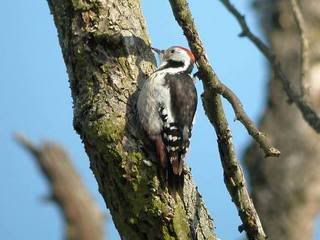 Female Middle Spotted Woodpeckers are very similar to males in plumage. They, too, have a red crown but it is not as bright as on males and does not extend as far back towards the nape. The red is also lighter, sometimes perhaps orange or rusty brown at the rear. The white forehead is often tinged yellow. But these features are generally difficult to judge in the field and may be so slight that they are unreliable, except on close-up views in the breeding season. On this photo of a female, taken at Kamond in Hungary (Gábor Vasuta), the red crown peters out at the rear and is rather dull. The flanks are not as well marked with black as on males, either.
Female Middle Spotted Woodpeckers are very similar to males in plumage. They, too, have a red crown but it is not as bright as on males and does not extend as far back towards the nape. The red is also lighter, sometimes perhaps orange or rusty brown at the rear. The white forehead is often tinged yellow. But these features are generally difficult to judge in the field and may be so slight that they are unreliable, except on close-up views in the breeding season. On this photo of a female, taken at Kamond in Hungary (Gábor Vasuta), the red crown peters out at the rear and is rather dull. The flanks are not as well marked with black as on males, either.
Middle Spotted Woodpecker: adult male ID
 Adult male Middle Spotted Woodpeckers have a bright, strong red crown. In the breeding season the red feathers jut out at the rear almost like a crest. On average males are also larger and heavier than females and have slightly longer bills. But these factors are not useful in the field. Even though at a distance the complete bright red crown that extends to the very rear, and which is typical of males, can be seen. Photo taken at Doba in Hungary (Gábor Vasuta).
Adult male Middle Spotted Woodpeckers have a bright, strong red crown. In the breeding season the red feathers jut out at the rear almost like a crest. On average males are also larger and heavier than females and have slightly longer bills. But these factors are not useful in the field. Even though at a distance the complete bright red crown that extends to the very rear, and which is typical of males, can be seen. Photo taken at Doba in Hungary (Gábor Vasuta).
Middle Spotted Woodpecker: general ID
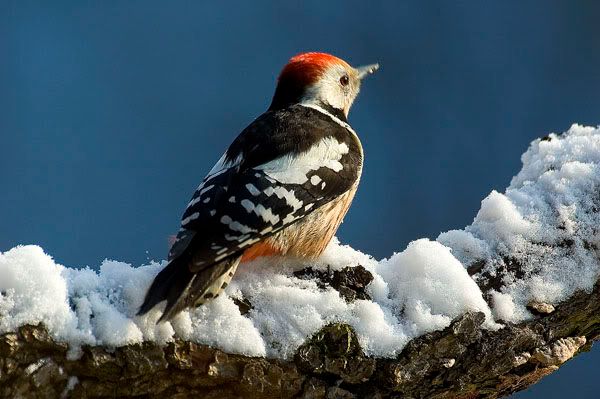 Measurements: Length 20-22 cm. Wingspan 33-34 cm. Despite its vernacular and scientific names Middle Spotted Woodpecker is not mid-way in size between its Dendrocopos relatives, the smaller Lesser Spotted and larger Great Spotted and Syrian. Middle Spotted is much closer to the two larger species in all measurements, being just 15% smaller, but is around 40% larger than Lesser Spotted. Middle Spotted differs from all its European relatives in being almost totally monomorphic, i.e. males and females are almost identical in appearance. Differences between the sexes will be dealt with in other posts in this blog. Both adults are essentially black and white although the white areas are rather dusky. Middle Spotted Woodpecker has less black on the face than other Dendrocopos species. Indeed, the cheeks, ear-coverts, forehead, chin, throat, neck and upper breast are all shades of off-white with a cream, buff or grey tinge. Lores and nasal tufts grey. There is only the suggestion of a malar stripe and on some birds it may be lacking altogether. Even when a malar is present it never starts from the lower mandible, but rather begins a little way short. In this respect it differs from all other European Dendrocopos species. The ear-coverts are creamy white, often rather dusky, and are crossed only partially by a black post-auricular stripe. The extent that the post-auricular stripe crosses the ear-coverts varies, but it never meets the black nape. However, on some views, particularly when birds are twisting their head during foraging, it may seem that the post-auricular stripe touches the nape. The iris is dark red, but usually appears black, and stands out as a dark bead in the otherwise pale face. An isolated black crescent-shaped area is formed below the cheek on the side of the neck where the base of the post-auricular stripe, whatever malar stripe there is and the shoulder stripe meet. The shoulder stripe runs by the side of the throat down to the upper sides of the breast where it merges into black streaks on the upper flank. The thin black line down back of neck linking the crown to the mantle recalls Syrian rather than Great Spotted as there are no post-auricular stripes joining it at the sides. The dark eye is clearly isolated in the white side of the face. Both adults have a red crown bordered by the white of the face. The lower breast, belly and flanks are essentially creamy white though this varies from dirty white to buff and there are often distinct yellowish tones on the flanks, belly and sometimes the breast. This yellowish wash may reach the leg feathering on some birds. The extent and strength of yellow is very variable. The lower belly, under-tail coverts and ventral area are flushed with pink. This pink spreads higher up the under-body than similar colouration does on other pied woodpeckers. It is also always paler than the red of the crown (recalling Syrian rather than Great Spotted). The flanks are heavily streaked with long black lines (recalling White-backed). The mantle, inner scapulars, back, rump and upper tail coverts are matt black. The outer scapulars are creamy white and form ovals, similar to but smaller than, those of Syrian and Great Spotted. The primaries and secondaries are black, heavily dotted and barred with white. Some of the rows of white spots on the flight feathers almost join to form bars. The upper wing-coverts are black and the inner median wing-coverts white with black bases. The greater coverts are black with white tips. The axillaries are dusky or dirty white. Most of the tail is black though the outer two rectrices are white dotted with 2 or 3 black bars (recalling Great Spotted rather than Syrian) whilst the third rectrix is sometimes edged white. The bill is visibly small and weak, mostly grey but with the lower mandible paler. The legs are grey. Males and females overlap in all measurements and features, but all size differences are rather subtle and slight and probably more related to feeding and foraging behaviour than to visual recognition. This photo of an adult male, showing most of the classic ID features, was taken in northern Hungary (László Nehézy).
Measurements: Length 20-22 cm. Wingspan 33-34 cm. Despite its vernacular and scientific names Middle Spotted Woodpecker is not mid-way in size between its Dendrocopos relatives, the smaller Lesser Spotted and larger Great Spotted and Syrian. Middle Spotted is much closer to the two larger species in all measurements, being just 15% smaller, but is around 40% larger than Lesser Spotted. Middle Spotted differs from all its European relatives in being almost totally monomorphic, i.e. males and females are almost identical in appearance. Differences between the sexes will be dealt with in other posts in this blog. Both adults are essentially black and white although the white areas are rather dusky. Middle Spotted Woodpecker has less black on the face than other Dendrocopos species. Indeed, the cheeks, ear-coverts, forehead, chin, throat, neck and upper breast are all shades of off-white with a cream, buff or grey tinge. Lores and nasal tufts grey. There is only the suggestion of a malar stripe and on some birds it may be lacking altogether. Even when a malar is present it never starts from the lower mandible, but rather begins a little way short. In this respect it differs from all other European Dendrocopos species. The ear-coverts are creamy white, often rather dusky, and are crossed only partially by a black post-auricular stripe. The extent that the post-auricular stripe crosses the ear-coverts varies, but it never meets the black nape. However, on some views, particularly when birds are twisting their head during foraging, it may seem that the post-auricular stripe touches the nape. The iris is dark red, but usually appears black, and stands out as a dark bead in the otherwise pale face. An isolated black crescent-shaped area is formed below the cheek on the side of the neck where the base of the post-auricular stripe, whatever malar stripe there is and the shoulder stripe meet. The shoulder stripe runs by the side of the throat down to the upper sides of the breast where it merges into black streaks on the upper flank. The thin black line down back of neck linking the crown to the mantle recalls Syrian rather than Great Spotted as there are no post-auricular stripes joining it at the sides. The dark eye is clearly isolated in the white side of the face. Both adults have a red crown bordered by the white of the face. The lower breast, belly and flanks are essentially creamy white though this varies from dirty white to buff and there are often distinct yellowish tones on the flanks, belly and sometimes the breast. This yellowish wash may reach the leg feathering on some birds. The extent and strength of yellow is very variable. The lower belly, under-tail coverts and ventral area are flushed with pink. This pink spreads higher up the under-body than similar colouration does on other pied woodpeckers. It is also always paler than the red of the crown (recalling Syrian rather than Great Spotted). The flanks are heavily streaked with long black lines (recalling White-backed). The mantle, inner scapulars, back, rump and upper tail coverts are matt black. The outer scapulars are creamy white and form ovals, similar to but smaller than, those of Syrian and Great Spotted. The primaries and secondaries are black, heavily dotted and barred with white. Some of the rows of white spots on the flight feathers almost join to form bars. The upper wing-coverts are black and the inner median wing-coverts white with black bases. The greater coverts are black with white tips. The axillaries are dusky or dirty white. Most of the tail is black though the outer two rectrices are white dotted with 2 or 3 black bars (recalling Great Spotted rather than Syrian) whilst the third rectrix is sometimes edged white. The bill is visibly small and weak, mostly grey but with the lower mandible paler. The legs are grey. Males and females overlap in all measurements and features, but all size differences are rather subtle and slight and probably more related to feeding and foraging behaviour than to visual recognition. This photo of an adult male, showing most of the classic ID features, was taken in northern Hungary (László Nehézy).
Thursday, 13 September 2007
Woodpecker signs: ringing
Ringing is a series of small, more or less horizontal, holes or grooves which woodpeckers peck around a trunk in order to get at and drink sap. Ringing is sometimes referred to as “girdling" and the peck marks called wells. Ringing is less common amongst European woodpeckers than it is, for example, amongst North American species: there are no true sapsuckers in Europe. Great Spotted, Middle Spotted and Three-toed Woodpeckers are known to ring trees for sap. Syrian, Lesser Spotted and Green Woodpeckers probably do not ring trees themselves though they do take sap from wells made by other. Black Woodpeckers do not ring trees but drink sap from large holes knocked into pines. Woodpeckers ring trees so that sap flows out from the created wells and is mostly done in spring when the sap is rising. The wells pierce the bark and cambial strata of the trunk to tap into the sap conducting routes of the tree. Sunny south-facing trunks, where sap rises first and fastest are often ringed first and most intensely. On productive trees the ringing lines will continue and encircled (girdle) the trunk. Such line may be broken or zigzagged. Several tree species are ringed though pines Pinus and limes Tilia are favourites. Intense ringing can leave wide areas of exposed bark-less trunk. In a given population of Great Spotted Woodpecker most will ring trees but only certain birds will regularly and intensely ring trees.
Woodpecker signs: holes
 The ability that woodpeckers have of being able to excavate holes in trees is arguably the one thing that sets them apart from other birds. In Europe woodpeckers are primary hole-excavators, that is, they are the bird family that contributes most to the process of cavity making in forests. The fact that woodpeckers can excavate their own nesting and roosting cavities is one of the main reasons why they are successful. There are many advantages for both parents and chicks in being able to raise and be raised in the weatherproof haven of a chamber inside a tree. Being able to roost in such shelters is obviously an advantage for adults, too. There are three basic types of tree holes made by woodpeckers: nest holes, roost holes, feeding holes. Holes are arguably the most recognisable sign of woodpecker presence. There can be a significant turn over of nest holes in an area each year. Some are lost, as trees are felled or storm damaged, and new ones created. Old holes become unsuitable due to wear and tear, filling with water (from melting snow or rain), become infested with parasites, clogged with fungi or are usurped by other birds, mammals or wasp, hornets and bees. Some woodlands (for birds and birders high quality woodlands, for foresters low quality woodlands) are riddled with woodpecker holes. Favoured trees may contain several holes, made by one species or by several. As a rule, all woodpeckers will nest as high up in a tree as practical. Tree height and the height of the nest-hole entrance, both increase with increasing woodpecker body size. Though all kinds of factors (location, tree species, availability of suitable trees, forestry practises, predation risk) influence hole entrance height, in general Great Spotted, White-backed, Black and Green Woodpeckers will nest highest up in trees. Wryneck, Middle Spotted, Syrian and Grey-headed Woodpeckers will nest at medium heights, and Lesser Spotted and Three-toed Woodpecker nests will be the lowest. Of course, there will always be exceptions. Holes used for roosting rarely differ from nest-holes. This is because they are in fact often old nest-holes. Some woodpeckers excavate specific roost holes if there is a lack of cavities in an area. From the outside these will appear like nest-holes, though on the inside they may be less precise as those which are intended to house a brood of chicks. Notes on feeding-holes are mentioned in other posts in this blog. I will also post more on specific, species related, nest holes in this blog as I obtain the relevant photos. The photo here shows an adult male Three-toed Woodpecker at at nesthole site in Finland (Jari Peltomaki). The hole is around one metre above ground level. Such a height is not unusual for this species though most (but not all) other woodpecker species prefer to nest at a higher level.
The ability that woodpeckers have of being able to excavate holes in trees is arguably the one thing that sets them apart from other birds. In Europe woodpeckers are primary hole-excavators, that is, they are the bird family that contributes most to the process of cavity making in forests. The fact that woodpeckers can excavate their own nesting and roosting cavities is one of the main reasons why they are successful. There are many advantages for both parents and chicks in being able to raise and be raised in the weatherproof haven of a chamber inside a tree. Being able to roost in such shelters is obviously an advantage for adults, too. There are three basic types of tree holes made by woodpeckers: nest holes, roost holes, feeding holes. Holes are arguably the most recognisable sign of woodpecker presence. There can be a significant turn over of nest holes in an area each year. Some are lost, as trees are felled or storm damaged, and new ones created. Old holes become unsuitable due to wear and tear, filling with water (from melting snow or rain), become infested with parasites, clogged with fungi or are usurped by other birds, mammals or wasp, hornets and bees. Some woodlands (for birds and birders high quality woodlands, for foresters low quality woodlands) are riddled with woodpecker holes. Favoured trees may contain several holes, made by one species or by several. As a rule, all woodpeckers will nest as high up in a tree as practical. Tree height and the height of the nest-hole entrance, both increase with increasing woodpecker body size. Though all kinds of factors (location, tree species, availability of suitable trees, forestry practises, predation risk) influence hole entrance height, in general Great Spotted, White-backed, Black and Green Woodpeckers will nest highest up in trees. Wryneck, Middle Spotted, Syrian and Grey-headed Woodpeckers will nest at medium heights, and Lesser Spotted and Three-toed Woodpecker nests will be the lowest. Of course, there will always be exceptions. Holes used for roosting rarely differ from nest-holes. This is because they are in fact often old nest-holes. Some woodpeckers excavate specific roost holes if there is a lack of cavities in an area. From the outside these will appear like nest-holes, though on the inside they may be less precise as those which are intended to house a brood of chicks. Notes on feeding-holes are mentioned in other posts in this blog. I will also post more on specific, species related, nest holes in this blog as I obtain the relevant photos. The photo here shows an adult male Three-toed Woodpecker at at nesthole site in Finland (Jari Peltomaki). The hole is around one metre above ground level. Such a height is not unusual for this species though most (but not all) other woodpecker species prefer to nest at a higher level.
Woodpecker signs: ruts in turf
Woodpecker signs: cones
 Conifer cones worked on by woodpeckers, to obtain the seeds inside, are opened in a different manner from those fed on by mammals. The cone scales are broken lengthways and have a jagged, ruffled appearance. Piles of such cones are often found below anvils or single cones found wedged in cracks. Woodpeckers fly with cones to anvils, wedge them, tip upwards, and work them systematically, turning them around in order to open upon the scales around the whole cone. Cone scales are prised open sideways to get at the seeds. This causes the distinct ruffled appearance. Cones are not damaged on the base of the cone, where they are wedged into anvils and where the scales are also tighter. It has been calculated that it takes a Great Spotted Woodpecker around four minutes to empty a cone of its seeds and in this time the cone can be pecked some 800 times.
Conifer cones worked on by woodpeckers, to obtain the seeds inside, are opened in a different manner from those fed on by mammals. The cone scales are broken lengthways and have a jagged, ruffled appearance. Piles of such cones are often found below anvils or single cones found wedged in cracks. Woodpeckers fly with cones to anvils, wedge them, tip upwards, and work them systematically, turning them around in order to open upon the scales around the whole cone. Cone scales are prised open sideways to get at the seeds. This causes the distinct ruffled appearance. Cones are not damaged on the base of the cone, where they are wedged into anvils and where the scales are also tighter. It has been calculated that it takes a Great Spotted Woodpecker around four minutes to empty a cone of its seeds and in this time the cone can be pecked some 800 times.The phot here shows a conifer cones wedged into a tree crevice anvil by Great Spotted Woodpecker in Budapest, Hungary (Szabolcs Kókay)
Woodpecker signs: nuts
 This photo shows a hazelnut wedged in a tree-crevice. This anvil was used by a Great Spotted Woodpecker in Budapest, Hungary (Szabolcs Kókay). Woodpeckers open nuts by pecking the hard shell until it shatters. Syrian and Great Spotted Woodpeckers regularly feed on nuts. They do not seem to be able to make neat holes in nutshells as rodents do. It takes numerous pecks to break open a shell, depending upon which kind of nut is being dealt with. Hazelnuts take longer to break open than, for example, walnuts. Unopened but tried nuts are dotted with peck marks rather than the gnawing marks made by the teeth of rodents. The sizes and shapes of the beak tips of birds that feed on nuts differ. Although it is not always clear these are sometimes diagnostic. The marks left on nuts by woodpeckers are dagger or chisel-shaped (vertical) whereas those left by Nuthatches Sitta europaea are crescent-shaped (horizontal). The chisel shape of woodpecker beaks is ideal for splitting nutshells as nuts split most easily along vertical fault lines. Woodpeckers have learned to exploit this. Nuts are always placed in the anvil downwards and pecked at lengthways in a line until they crack. Nuthatches never work a line to open a nut but rather chisel a round hole like a rodent does.
This photo shows a hazelnut wedged in a tree-crevice. This anvil was used by a Great Spotted Woodpecker in Budapest, Hungary (Szabolcs Kókay). Woodpeckers open nuts by pecking the hard shell until it shatters. Syrian and Great Spotted Woodpeckers regularly feed on nuts. They do not seem to be able to make neat holes in nutshells as rodents do. It takes numerous pecks to break open a shell, depending upon which kind of nut is being dealt with. Hazelnuts take longer to break open than, for example, walnuts. Unopened but tried nuts are dotted with peck marks rather than the gnawing marks made by the teeth of rodents. The sizes and shapes of the beak tips of birds that feed on nuts differ. Although it is not always clear these are sometimes diagnostic. The marks left on nuts by woodpeckers are dagger or chisel-shaped (vertical) whereas those left by Nuthatches Sitta europaea are crescent-shaped (horizontal). The chisel shape of woodpecker beaks is ideal for splitting nutshells as nuts split most easily along vertical fault lines. Woodpeckers have learned to exploit this. Nuts are always placed in the anvil downwards and pecked at lengthways in a line until they crack. Nuthatches never work a line to open a nut but rather chisel a round hole like a rodent does.
Woodpecker signs: anvils
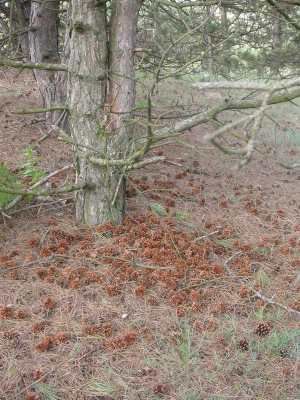 The anvil (sometimes termed “workshop" or “smithy") is usually a natural hole, crevice or crack in a tree, log, post or even a wall, where woodpeckers wedge and process hard food items such as nuts, cones, fruit stones and large insects. Great Spotted, Syrian and possibly Green Woodpeckers use anvils. Ingvar Stenberg tells me that in Norway White-backed Woodpeckers use anvils for opening nuts (like nuthatches) but I have yet to find evidence of this in Central Europe. An important difference between anvils used by Nuthatches and those used by woodpeckers is that Nuthatch only use an anvil once, thus no piles of debris accumulate beneath it, whereas woodpeckers use favourite anvils repeatedly. Great Spotted Woodpeckers are unique in creating customised anvils to suit the food item regularly fed upon in an area. Anvils are often used for long periods hence debris, cones, nutshells, hard insect remains, accumulate beneath them. Sometimes trees with several crevices used as anvils are dotted with wedged cones and nuts and in winter take on a strange Christmas tree appearance. Cones can be wedged in anvils so well that it is sometimes hard to remove them. Conifer cones which woodpeckers have worked upon in anvils to extract the seeds, are rather crudely “beaten up", not systematically and neatly worked, as is done by Crossbills Loxia. Cones worked by squirrels and mice are neater. Woodpeckers break the cone scales lengthways. The stones of plums, almonds, cherries and apricots wedged in anvils are usually the result of Syrian or Great Spotted Woodpecker feeding. Cockchafer remains, too, strongly indicate these two species. The photo here shows opened and discarded conifer cones below a Great Spotted Woodpecker anvil in Hungary (Szabolcs Kókay).
The anvil (sometimes termed “workshop" or “smithy") is usually a natural hole, crevice or crack in a tree, log, post or even a wall, where woodpeckers wedge and process hard food items such as nuts, cones, fruit stones and large insects. Great Spotted, Syrian and possibly Green Woodpeckers use anvils. Ingvar Stenberg tells me that in Norway White-backed Woodpeckers use anvils for opening nuts (like nuthatches) but I have yet to find evidence of this in Central Europe. An important difference between anvils used by Nuthatches and those used by woodpeckers is that Nuthatch only use an anvil once, thus no piles of debris accumulate beneath it, whereas woodpeckers use favourite anvils repeatedly. Great Spotted Woodpeckers are unique in creating customised anvils to suit the food item regularly fed upon in an area. Anvils are often used for long periods hence debris, cones, nutshells, hard insect remains, accumulate beneath them. Sometimes trees with several crevices used as anvils are dotted with wedged cones and nuts and in winter take on a strange Christmas tree appearance. Cones can be wedged in anvils so well that it is sometimes hard to remove them. Conifer cones which woodpeckers have worked upon in anvils to extract the seeds, are rather crudely “beaten up", not systematically and neatly worked, as is done by Crossbills Loxia. Cones worked by squirrels and mice are neater. Woodpeckers break the cone scales lengthways. The stones of plums, almonds, cherries and apricots wedged in anvils are usually the result of Syrian or Great Spotted Woodpecker feeding. Cockchafer remains, too, strongly indicate these two species. The photo here shows opened and discarded conifer cones below a Great Spotted Woodpecker anvil in Hungary (Szabolcs Kókay).
Woodpecker signs: dust baths
Dust bathing is not common amongst woodpeckers, probably because of the essentially arboreal lifestyle that most lead, that is, most are reluctant to drop to the ground for any length of time. Indeed, some woodpeckers will not sit on the ground for any reason. However, as with bathing in water, it may be the case that dusting is practised by most woodpeckers but is rarely observed. Black Woodpeckers are known to dust bathe and the more terrestrial Wryneck and Green Woodpecker also occasionally indulges in this activity. Dust baths are often temporary and located on forest tracks. They can be recognised by wing, body and foot prints, though it is often impossible to assign these to one species.
Woodpecker signs: barking?
Many mammals feed on and mark trees: beavers, voles, mice, squirrels, hares, rabbits, deer, even sheep and goats. Generally the marks they leave are easy to separate from those left by woodpeckers, as gnawing and individual tooth marks are left by mammals rather than peck marks. Barking refers to the marks left by deer and elk when they have eaten tree bark. I include it here because such markings can be confused with woodpecker work. Most barking takes place in spring when trees are growing and thus their sap is rising. This of course is also a period of great woodpecker activity. The mammals tear off bark in long strips (usually from bottom up) and leave large incisor marks. In winter bark is tougher and more firmly gripped onto the trunk, so the marks left by deer then are different, with clear lines or furrows left. By contrast woodpecker leave fine peck marks when stripping off bark and the bark is torn off in short sections and from top to bottom.
Woodpecker signs: wood-chips
 Woodpeckers produce wood-chips when they excavate holes or bore into timber for prey. Wood-chips are left where they fall and often accumulate below work sites. It is usually easier to distinguish wood-chips that are the result of nest-hole excavation and attribute them to species, than it is those that have resulted from foraging. The size of wood-chips is a major clue. Those that are 10cm or more are inevitably the work of Black Woodpecker. But when Green Woodpecker excavates soft wood trees such as willows, aspen and fruit trees, the wood-chips which litter the ground below can also be quite large, sometimes 7-8cm, but never as large as those of Black Woodpecker. The size of wood-chips also depends upon the structure of the wood, that is, whether it long-grained or short-grained and whether the fibres are tough or not. The quality of the wood-chips is important. It should be remembered that only Black and Great Spotted Woodpeckers regularly work on healthy, sound wood and thus clean, solid wood-chips with no signs of decay or fungi are usually the result of work done by these two species. All other European woodpeckers tend to excavate, or forage upon, soft or rotten wood, usually affected by fungi. Piles of wood dust at the base of dead stumps may indicate White-backed Woodpeckers, which often completely pulverise timber (see photo) that contains beetle larvae. This photo shows a typical feeding site of White-backed Woodpecker. A finely shaved rotting stump, from top to ground level and with wood-chips but also powder-like debris. Bükk Hills, Hungary (Szabolcs Kókay)
Woodpeckers produce wood-chips when they excavate holes or bore into timber for prey. Wood-chips are left where they fall and often accumulate below work sites. It is usually easier to distinguish wood-chips that are the result of nest-hole excavation and attribute them to species, than it is those that have resulted from foraging. The size of wood-chips is a major clue. Those that are 10cm or more are inevitably the work of Black Woodpecker. But when Green Woodpecker excavates soft wood trees such as willows, aspen and fruit trees, the wood-chips which litter the ground below can also be quite large, sometimes 7-8cm, but never as large as those of Black Woodpecker. The size of wood-chips also depends upon the structure of the wood, that is, whether it long-grained or short-grained and whether the fibres are tough or not. The quality of the wood-chips is important. It should be remembered that only Black and Great Spotted Woodpeckers regularly work on healthy, sound wood and thus clean, solid wood-chips with no signs of decay or fungi are usually the result of work done by these two species. All other European woodpeckers tend to excavate, or forage upon, soft or rotten wood, usually affected by fungi. Piles of wood dust at the base of dead stumps may indicate White-backed Woodpeckers, which often completely pulverise timber (see photo) that contains beetle larvae. This photo shows a typical feeding site of White-backed Woodpecker. A finely shaved rotting stump, from top to ground level and with wood-chips but also powder-like debris. Bükk Hills, Hungary (Szabolcs Kókay)
Wednesday, 12 September 2007
Woodpecker signs: droppings
Finding and identifying woodpecker droppings is one of the great challenges that lovers of the Picidae face. Finding a woodpecker faeces sac in a forest is probably harder than finding the famous needle in a haystack. Woodpecker droppings quickly rot, whereas needles, made as they are from steel, last for ages. Green Woodpecker droppings are the only ones that are likely to be found with any regularity as this species often feed on lawns and areas with flat-cropped turf and so its droppings can be conspicuous, at least for a while. They are greyish, elongated, cylindrical and composed of invertebrate remains, often chitin, dried-out ant bodies and usually enclosed in a membrane, a sac. Such droppings are usually in piles at foraging sites or nearby, and may resemble soggy cigarette butts. They might be confused with small mammal droppings. Green Woodpecker droppings are most often found in winter, when birds do most of their foraging on anthills.
Woodpecker signs: tracks
In Europe only one woodpecker species, Green Woodpecker, is really terrestrial. Grey-headed Woodpecker is partly so, Wryneck and Black occasionally work on the floor when gathering ants, but all other species rarely forage on the ground itself, though some, such as White-backed and Gresat Spotted, often descend to low levels to work on fallen logs. The only realistic situation in which to find woodpecker tracks (i.e. footprints) is after snowfall. Woodpeckers only hop in mud by accident. The first thing to remember, of course, is that all European woodpeckers except Three-toed (sic) have four toes, two pointing forwards and two back. Nine out of the ten European woodpeckers have a syndactyl formation of the toes (the second and third toes point forwards in parallel and toes one and four backwards). Three-toed Woodpecker has the first toe missing, with just toe four pointing backwards and toes two and three forwards). In the rare event that woodpecker tracks are found on the ground (in mud or snow) the quality of the tracks will depend upon the ground conditions.
Woodpecker signs: feeding holes
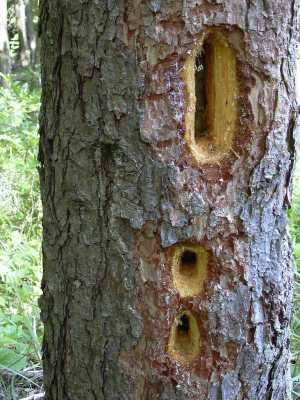 Several things differentiate the holes that woodpeckers create by foraging from those made for use as nesting cavities. Feeding holes do not lead to deep chambers, they almost always show pecks marks around the entrance, the hole will be irregular in shape and wood-chips are invariably piled up below the site outside the breeding season. Feeding holes are frequently at low levels on trees whereas nest-holes are usually high up. Fedding holes are often made in heavily rotting wood whereas neting holes are generally not. Holes made by Black Woodpecker to get at timber-dwelling carpenter ant colonies are often long oval, sometimes almost square, slits. Such holes can be up to 50cm long and 20cm wide. The photo of a typical, fresh, feeding site of Black Woodpecker in a pine with heart rot was taken in the Bukk Hills in northern Hungary (Szabolcs Kókay).
Several things differentiate the holes that woodpeckers create by foraging from those made for use as nesting cavities. Feeding holes do not lead to deep chambers, they almost always show pecks marks around the entrance, the hole will be irregular in shape and wood-chips are invariably piled up below the site outside the breeding season. Feeding holes are frequently at low levels on trees whereas nest-holes are usually high up. Fedding holes are often made in heavily rotting wood whereas neting holes are generally not. Holes made by Black Woodpecker to get at timber-dwelling carpenter ant colonies are often long oval, sometimes almost square, slits. Such holes can be up to 50cm long and 20cm wide. The photo of a typical, fresh, feeding site of Black Woodpecker in a pine with heart rot was taken in the Bukk Hills in northern Hungary (Szabolcs Kókay).Woodpecker signs: general
 Most birds are located visually or by call, however some birds leave visual clues that betray their presence. These signs include footprints, feathers, and pellets and, of course, nests. Perhaps more than any other bird family, woodpeckers leave a variety of obvious signs that indicate that they are present in an area. Holes in trees, feeding marks on stumps, logs and trees, anvils, food stores, wood-chips on the ground beneath holes, all of these are a result of woodpecker activity. Many of these signs are unique to certain species, indeed in some cases they can be described as diagnostic. Knowledge of such signs, together with tree and habitat preferences, can lead to a confident assertion of which woodpecker species are present in a given area. In winter, when woodpeckers are less vocal, such signs are very useful clues. Indeed, winter is an excellent season in which to search for, and study, such signs as most trees are without leaves and so signs are easier to discover. It is difficult to state for sure which species is responsible for the worked tree in the photo here on the left. Black, Great Spotted and White-backed Woodpecker are three candidates. It is also possible that two or three of these species contributed to the resultant hacked out stump. The shot was taken in an old forest in Lithania (Juozas Miskinis).
Most birds are located visually or by call, however some birds leave visual clues that betray their presence. These signs include footprints, feathers, and pellets and, of course, nests. Perhaps more than any other bird family, woodpeckers leave a variety of obvious signs that indicate that they are present in an area. Holes in trees, feeding marks on stumps, logs and trees, anvils, food stores, wood-chips on the ground beneath holes, all of these are a result of woodpecker activity. Many of these signs are unique to certain species, indeed in some cases they can be described as diagnostic. Knowledge of such signs, together with tree and habitat preferences, can lead to a confident assertion of which woodpecker species are present in a given area. In winter, when woodpeckers are less vocal, such signs are very useful clues. Indeed, winter is an excellent season in which to search for, and study, such signs as most trees are without leaves and so signs are easier to discover. It is difficult to state for sure which species is responsible for the worked tree in the photo here on the left. Black, Great Spotted and White-backed Woodpecker are three candidates. It is also possible that two or three of these species contributed to the resultant hacked out stump. The shot was taken in an old forest in Lithania (Juozas Miskinis).
Syrian Woodpecker: female fledgling photo
 This young Syrian Woodpecker had just fledged. The photo was taken on Csepel Island, Budapest, Hungary in 2006 (Szabolcs Kókay). There does not seem to be any red on the crown of this bird, hence it is a female .A young male would show some red on the crown, even on a shot from this angle. Note also the dark smudge behind the eye, and a touch of red on the breast. The white areas are all rather dirty and scruffy, which is typical of juveniles.
This young Syrian Woodpecker had just fledged. The photo was taken on Csepel Island, Budapest, Hungary in 2006 (Szabolcs Kókay). There does not seem to be any red on the crown of this bird, hence it is a female .A young male would show some red on the crown, even on a shot from this angle. Note also the dark smudge behind the eye, and a touch of red on the breast. The white areas are all rather dirty and scruffy, which is typical of juveniles.
Syrian Woodpecker: tail pattern
 This photo shows the tail of a dead juvenile Syrian Woopdecker (though age cannot be determined by this photo) found on Csepel Island, Budapest, Hungary, 2005 (Szabolcs Kókay). Note that there are white markings only on the two outer-most feathers (rectrices). Minimal white in the tail is an important feature that separates Syrian Woodpecker from Great Spotted Woodpecker (all ages and both sexes).
This photo shows the tail of a dead juvenile Syrian Woopdecker (though age cannot be determined by this photo) found on Csepel Island, Budapest, Hungary, 2005 (Szabolcs Kókay). Note that there are white markings only on the two outer-most feathers (rectrices). Minimal white in the tail is an important feature that separates Syrian Woodpecker from Great Spotted Woodpecker (all ages and both sexes).
Syrian Woodpecker: juvenile female (fledgling) ID
 Syrian Woodpecker nestlings can be sexed before they even leave the nest (as indeed can most other European woodpeckers). This photo was taken at a nest in an urban area on Csepel Island, Budapest, Hungary in June 2006 (Szabolcs Kókay). The chick is a female: note the small red patch on the forecrown. On a nestling male the red would typically extend further back across the crown. Note also the red smudge on the breast.
Syrian Woodpecker nestlings can be sexed before they even leave the nest (as indeed can most other European woodpeckers). This photo was taken at a nest in an urban area on Csepel Island, Budapest, Hungary in June 2006 (Szabolcs Kókay). The chick is a female: note the small red patch on the forecrown. On a nestling male the red would typically extend further back across the crown. Note also the red smudge on the breast.
Syrian Woodpecker: juvenile female ID
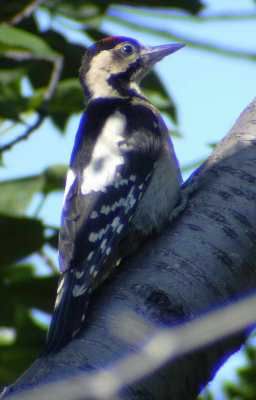 Juvenile female Syrian Woodpeckers have a smaller amount of red on the crown when compared to juvenile males. This photo of a juvenile was taken on Csepel Island, Budapest, Hungary in 2005 (Szabolcs Kókay). Note the small red patch of the crown which indicates a female. The dusky smudge around the eye is typical of all juveniles, but is variable. The lack of a post-auricular stripe and minimal white in the tail are features which separate from juvenile Great Spotted, as they also do in adults.
Juvenile female Syrian Woodpeckers have a smaller amount of red on the crown when compared to juvenile males. This photo of a juvenile was taken on Csepel Island, Budapest, Hungary in 2005 (Szabolcs Kókay). Note the small red patch of the crown which indicates a female. The dusky smudge around the eye is typical of all juveniles, but is variable. The lack of a post-auricular stripe and minimal white in the tail are features which separate from juvenile Great Spotted, as they also do in adults.
Syrian Woodpecker: juvenile male ID
Juvenile Syrian Woodpeckers of both sexes have a black-bordered red crown but the area of red is larger on males, covering most of the crown with a thinner black border. These features are not, however, easy to see in the field.
Syrian Woodpecker: juvenile ID
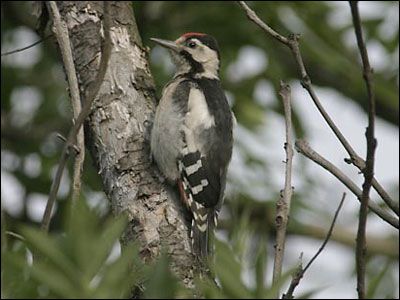 Juvenile Syrian Woodpeckers of both sexes can be easily separated from adults because they have all red crowns. Most also have a reddish breast band or gorget, or at least a hint of such a band, across the breast. This recalls races of Great Spotted from North Africa and some birds in Iberia. Eyes browner, not as deep red as adults. Juvenile Syrians are best separated from juvenile Great Spotted using some of the features mentioned above for adults, in particular more white on head and less on tail than in Great Spotted. Some juvenile Great Spotteds may have a little red or pink on the breast but this never forms a real band as in most Syrians. Juvenile Syrians typically show dark streaking on the flanks (recalling Middle Spotted rather than Great Spotted). Some may lack streaking. As with adult birds, the post-auricular stripe does not reach the nape in juveniles but beware juvenile Great Spotted here as some may also lack this stripe or at least part of it. Given the variability in face patterns the outer tail is perhaps the most reliable feature in safely separating juveniles of the two species. The photo above shows a juvenile female, taken in Austria, July 2004 (Göran Ekström).
Juvenile Syrian Woodpeckers of both sexes can be easily separated from adults because they have all red crowns. Most also have a reddish breast band or gorget, or at least a hint of such a band, across the breast. This recalls races of Great Spotted from North Africa and some birds in Iberia. Eyes browner, not as deep red as adults. Juvenile Syrians are best separated from juvenile Great Spotted using some of the features mentioned above for adults, in particular more white on head and less on tail than in Great Spotted. Some juvenile Great Spotteds may have a little red or pink on the breast but this never forms a real band as in most Syrians. Juvenile Syrians typically show dark streaking on the flanks (recalling Middle Spotted rather than Great Spotted). Some may lack streaking. As with adult birds, the post-auricular stripe does not reach the nape in juveniles but beware juvenile Great Spotted here as some may also lack this stripe or at least part of it. Given the variability in face patterns the outer tail is perhaps the most reliable feature in safely separating juveniles of the two species. The photo above shows a juvenile female, taken in Austria, July 2004 (Göran Ekström).
Syrian Woodpecker: adult female ID
 Adult female Syrian Woodpeckers are best separated from males by observing that their nape is black not red (as applies for male and female Great Spotted Woodpeckers).
Adult female Syrian Woodpeckers are best separated from males by observing that their nape is black not red (as applies for male and female Great Spotted Woodpeckers). This photo of a female was taken in the Evros Delta, Greece (Bill Baston). Note the lack of red on the nape. The complete white cheek, with no extensive post-auricular stripe, pink undertail and lack of white in the tail are all clearly visible.
Syrian Woodpecker: adult male ID
 Adult male Syrian Woodpecker has an all red nape patch and this is the only plumage feature that reliably separates adult males from adult females. Though sometimes difficult to judge in the field, this patch is also slightly larger than that of male Great Spotted Woodpecker as it extends further up the hind-crown and downwards towards the hind-neck. The front of the red patch is also closer to the eye than in Great Spotted. The red of the nape patch contrasts with the pink of the vent and under-tail coverts. This photo of an adult male was taken in Austria, in July 2004 (Göran Ekström). Note that on this bird the ventral area seems red rather than pink. Most Syrians show pink here but variation in colour tone is not uncommon and some birds show almost as deep a red as Great Spotted Woodpeckers. But the bird is clearly a full Syrian, not a hybrid (which do occur with Great Spotteds) as all the other ID features are clearly typical of Syrian.
Adult male Syrian Woodpecker has an all red nape patch and this is the only plumage feature that reliably separates adult males from adult females. Though sometimes difficult to judge in the field, this patch is also slightly larger than that of male Great Spotted Woodpecker as it extends further up the hind-crown and downwards towards the hind-neck. The front of the red patch is also closer to the eye than in Great Spotted. The red of the nape patch contrasts with the pink of the vent and under-tail coverts. This photo of an adult male was taken in Austria, in July 2004 (Göran Ekström). Note that on this bird the ventral area seems red rather than pink. Most Syrians show pink here but variation in colour tone is not uncommon and some birds show almost as deep a red as Great Spotted Woodpeckers. But the bird is clearly a full Syrian, not a hybrid (which do occur with Great Spotteds) as all the other ID features are clearly typical of Syrian.
Syrian Woodpecker: general ID
 Measurements: Length 22-23 cm. Wingspan 34-39 cm. Seems slimmer but not shorter in length, than Great Spotted, but in reality ison average the same size. From the rear the head and neck seem slimmer and longer due to the single vertical black stripe which runs downwards from the crown to the mantle. Syrian Woodpecker is a typical "pied" Dendrocopos woodpecker with mostly black upper-parts, mostly pale under-parts, a black and white head, black wings barred with white, large white oval scapular patches and a pink vent and under-tail coverts. Until recently the widely-used field guides tended to emphasize the lack of a black line (post-auricular stripe) across the ear-coverts as being the main feature separating Syrian from Great Spotted Woodpecker. This despite the fact that many papers on the species, some published decades ago, have emphasized the importance of other features, particularly tail pattern. The face pattern of Syrian Woodpecker is important, but it should not be regarded as the main difference (see below). Overall the black plumage (particularly crown, mantle and back) is matt rather than glossy. The under-side, and upper-side, of the outer rectrices are black with light white bars, unlike Great Spotted where the dark under-tail is always boldly barred white. This is a good feature to look for on flying birds, as this lack of white can be remarkably easy to see, certainly often easier than the face pattern. When seen from behind (e.g. when birds are climbing at a hole entrance) Syrian shows only a vertical black stripe which runs from the crown down the hind-neck to the mantle (in males this line runs from the red nape patch). It does not show the "black-cross" that Great Spotted has at the back of the head which is created by the two post-auricular stripes (one on each side of the face) touching the hind-crown, and thus the sides of the face appear very white. In atypical birds (where there is a hint of an extension from the malar stripe) or in birds moving or holding their heads askew (e.g. when foraging) it may sometimes seem that the nape is reached. The vent and under-tail coverts are pink. Though variable in shade from bird to bird, on some being almost red, this area is never scarlet as in a typical Great Spotted. The pink area also often reaches up onto the lower belly. "Syrians" which show scarlet here should be scrutinized for other plumage features as they may prove to be hybrids, but beware of individual variation. A black malar stripe leads from the lower mandible and meets the lateral neck stripe below the ear-coverts. Though in some birds it may curl up towards the ear-coverts, where it meets the lateral neck stripe, it never crosses the ear-coverts to form a post-auricular stripe. A lateral neck stripe extends from the malar stripe (which it joins below the ear-coverts) across the neck sides to the shoulder and upper breast. It rarely reaches the scapulars, whereas in adult Great Spotted it almost always does via a short connecting bar. Together with the malar stripe it forms a black crescent around the throat, recalling Middle Spotted Woodpecker. These facial features combine to create a more open, whiter appearance than Great Spotted. The white of the face extends in an unbroken sweep from the lores, around the eye (there is also usually more white above the eye than in Great Spotted) across the ear coverts, to the sides and rear of the neck and down to the breast. White spots on the black flight feathers are larger, but fewer in number than in Great Spotted, and form three wing-bars. The outer primaries are black and usually, but not always, with white tips. Though virtually impossible to see in the field (but visible on skins) white barring on the flight feathers usually reach closer to the feather shafts in Syrian. Under-parts are white or buff and lightly streaked with grey. Unlike Great Spotted there is no clear border between the pink under-tail coverts and the white belly, which merge into each other. The flanks are often lightly streaked with grey. But there is much individual variation with some birds being "clean" and others even showing faint barring. Syrian is never as heavily streaked as Middle Spotted and adult Great Spotted shows clean flanks. The forehead is white and this area is slightly larger and cleaner and extends further up onto the fore-crown than on Great Spotted. The lores usually appear whiter and cleaner, too. Nasal bristles are difficult to see in the field but are white or pale, whereas on Great Spotted they are black. The photo above shows an adult female in Budapest, Hungary in 2005 (Szabolcs Kókay). The lack of red on the nape indicates a female. Note the pink undertail, the white face lacking a black post-auricular stripe and also lack of white on the tail, all features separating Syrian from Great Spotted Woodpecker.
Measurements: Length 22-23 cm. Wingspan 34-39 cm. Seems slimmer but not shorter in length, than Great Spotted, but in reality ison average the same size. From the rear the head and neck seem slimmer and longer due to the single vertical black stripe which runs downwards from the crown to the mantle. Syrian Woodpecker is a typical "pied" Dendrocopos woodpecker with mostly black upper-parts, mostly pale under-parts, a black and white head, black wings barred with white, large white oval scapular patches and a pink vent and under-tail coverts. Until recently the widely-used field guides tended to emphasize the lack of a black line (post-auricular stripe) across the ear-coverts as being the main feature separating Syrian from Great Spotted Woodpecker. This despite the fact that many papers on the species, some published decades ago, have emphasized the importance of other features, particularly tail pattern. The face pattern of Syrian Woodpecker is important, but it should not be regarded as the main difference (see below). Overall the black plumage (particularly crown, mantle and back) is matt rather than glossy. The under-side, and upper-side, of the outer rectrices are black with light white bars, unlike Great Spotted where the dark under-tail is always boldly barred white. This is a good feature to look for on flying birds, as this lack of white can be remarkably easy to see, certainly often easier than the face pattern. When seen from behind (e.g. when birds are climbing at a hole entrance) Syrian shows only a vertical black stripe which runs from the crown down the hind-neck to the mantle (in males this line runs from the red nape patch). It does not show the "black-cross" that Great Spotted has at the back of the head which is created by the two post-auricular stripes (one on each side of the face) touching the hind-crown, and thus the sides of the face appear very white. In atypical birds (where there is a hint of an extension from the malar stripe) or in birds moving or holding their heads askew (e.g. when foraging) it may sometimes seem that the nape is reached. The vent and under-tail coverts are pink. Though variable in shade from bird to bird, on some being almost red, this area is never scarlet as in a typical Great Spotted. The pink area also often reaches up onto the lower belly. "Syrians" which show scarlet here should be scrutinized for other plumage features as they may prove to be hybrids, but beware of individual variation. A black malar stripe leads from the lower mandible and meets the lateral neck stripe below the ear-coverts. Though in some birds it may curl up towards the ear-coverts, where it meets the lateral neck stripe, it never crosses the ear-coverts to form a post-auricular stripe. A lateral neck stripe extends from the malar stripe (which it joins below the ear-coverts) across the neck sides to the shoulder and upper breast. It rarely reaches the scapulars, whereas in adult Great Spotted it almost always does via a short connecting bar. Together with the malar stripe it forms a black crescent around the throat, recalling Middle Spotted Woodpecker. These facial features combine to create a more open, whiter appearance than Great Spotted. The white of the face extends in an unbroken sweep from the lores, around the eye (there is also usually more white above the eye than in Great Spotted) across the ear coverts, to the sides and rear of the neck and down to the breast. White spots on the black flight feathers are larger, but fewer in number than in Great Spotted, and form three wing-bars. The outer primaries are black and usually, but not always, with white tips. Though virtually impossible to see in the field (but visible on skins) white barring on the flight feathers usually reach closer to the feather shafts in Syrian. Under-parts are white or buff and lightly streaked with grey. Unlike Great Spotted there is no clear border between the pink under-tail coverts and the white belly, which merge into each other. The flanks are often lightly streaked with grey. But there is much individual variation with some birds being "clean" and others even showing faint barring. Syrian is never as heavily streaked as Middle Spotted and adult Great Spotted shows clean flanks. The forehead is white and this area is slightly larger and cleaner and extends further up onto the fore-crown than on Great Spotted. The lores usually appear whiter and cleaner, too. Nasal bristles are difficult to see in the field but are white or pale, whereas on Great Spotted they are black. The photo above shows an adult female in Budapest, Hungary in 2005 (Szabolcs Kókay). The lack of red on the nape indicates a female. Note the pink undertail, the white face lacking a black post-auricular stripe and also lack of white on the tail, all features separating Syrian from Great Spotted Woodpecker.
Tuesday, 11 September 2007
A note on personal observations
I have watched woodpeckers in most European countries, however most of my woodpecker studies have been in Hungary, a country where nine (9) species of woodpecker can be seen. Grey-headed, Green, Black, Great Spotted, Syrian, Middle Spotted, White-backed Woodpecker and Lesser Spotted Woodpeckers are resident and Wryneck occurs from April to August. Three-toed Woodpecker does not occur in Hungary but is resident in all of the neighbouring countries. I regularly observe seven (7) species near my home in Budapest. If I am at home I can observe Syrian and Great Spotted Woodpeckers on an almost daily basis as both frequent our garden!
Sexual dimorphism in woodpeckers
 Most of the world's woodpeckers are visually sexually dimorphic and this is true, though to varying extents, for most European woodpeckers. But this dimorphism is often rather subtle so careful attention needs to be paid to sexual and age badges in plumage. All European woodpeckers are sexually dichromatic except Wryneck and Middle Spotted Woodpecker. Separating adult and juvenile males from females usually involves observing brightly coloured patches on the head, undertail or in the malar or moustachial stripes. Males show the largest sexual badges in plumage. This usually means some red (yellow in the case of Three-toed) on the crown or nape. Sometimes young birds show more red on the head than adults, as is the case with Syrian and Great Spotted. This is not clearly understood as with most other birds an increase in bright colouration usually develops with maturity. Males and females also usually differ in structure and size, but these differences are usually not noticeable in the field. Overall body size, wing length and bill length are invariably larger for males. The photo here shows a male Black Woodecker in Finland (Jari Peltomaki). This species exhibits minimal dimorphism in plumage between the sexes. Both males and females have red on the crown, though on males (as in this photo) the red is more extensive, covering the whole crown, whilst females only have red on the hind-crown.
Most of the world's woodpeckers are visually sexually dimorphic and this is true, though to varying extents, for most European woodpeckers. But this dimorphism is often rather subtle so careful attention needs to be paid to sexual and age badges in plumage. All European woodpeckers are sexually dichromatic except Wryneck and Middle Spotted Woodpecker. Separating adult and juvenile males from females usually involves observing brightly coloured patches on the head, undertail or in the malar or moustachial stripes. Males show the largest sexual badges in plumage. This usually means some red (yellow in the case of Three-toed) on the crown or nape. Sometimes young birds show more red on the head than adults, as is the case with Syrian and Great Spotted. This is not clearly understood as with most other birds an increase in bright colouration usually develops with maturity. Males and females also usually differ in structure and size, but these differences are usually not noticeable in the field. Overall body size, wing length and bill length are invariably larger for males. The photo here shows a male Black Woodecker in Finland (Jari Peltomaki). This species exhibits minimal dimorphism in plumage between the sexes. Both males and females have red on the crown, though on males (as in this photo) the red is more extensive, covering the whole crown, whilst females only have red on the hind-crown.
Great Spotted Woodpecker: races ID
There are strong clinal variations in the plumages and sizes of Great Spotted Woodpecker across its range. This is especially so as regards the colour of under-parts. Northern birds are generally larger with stubbier bills and whiter under-parts and foreheads, whilst southern European birds are smaller with slighter bills and often greyish under-parts. Great Spotteds in the British Isles (sometimes claimed as separate race “anglicus" have a slighter, more slender bill and are overall less stocky than the nominate major and continental pinetorum race. They are also matt black, and sometimes rather brownish, on the upper-parts and white areas maybe more creamy or buff. Adult pinetorum from most of mainland Europe is smaller than major, has white under-parts more grey or buff and a longer, thinner bill. Adult hispanus from Iberia is overall darker than most races. White parts are cream, less white on flight feathers and there is sometimes a faint pink flush or a few red blotches on the chest. The under-tail coverts are pinkish, not as bright red as on major. Adult hartertifound on Sardinia and Corsica is a large race with reduced white spots on the wings, very grey under-parts and with a deep red ventral area. Adult canariensis on Tenerife is also a large, dark race and with rather orange-red under-tail coverts and ventral area. Adult thanneri on Gran Canaria is similar to birds on Tenerife but rather pale brown below.
Great Spotted Woodpecker: juvenile ID
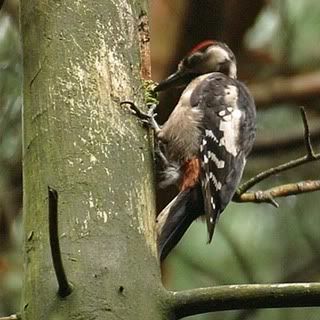 Both juvenile Great Spotted Woodpeckers (male and female) have complete red crowns with black borders at the sides. This immediately separates them from adults. Black areas are matt, not glossy, and often rather brown. There may be some dark barring on the white scapular ovals. Juveniles also have a weaker black malar stripe than adults and the post-auricular stripe is narrower and often does not quite reach the nape. Overall, white areas, particularly the cheeks, are greyer than on adult birds. Some grey streaks, occasionally light bars, cover the sides of the breast and flanks. The ventral area is pinkish, not as strong red (scarlet) as on adults. Some juveniles show a faint dark band across the chest and, more rarely, a flush of pink. The iris is brown, not as red as in adults. Juvenile males have a larger, brighter red crown than juvenile females. The black border to the red crown is also less extensive than on females. Juvenile males show the first signs of the sexually diagnostic red nape patch after the first moult at the end of summer into autumn. Juvenile females, unlike adult females, have red on the crown. This area of red is, however, smaller than on juvenile males and thus the black border is broader. The under-tail coverts are pink and less extensive than on juvenile males. The photo above shows a juvenile female in Germany (Thomas Kraft). Note the thick black border to the small red crown patch and the rather dull pink undertail. The post-auricular stripe is rather weak where it joins the nape and indeed seems to be broken: this is common in juveniles.
Both juvenile Great Spotted Woodpeckers (male and female) have complete red crowns with black borders at the sides. This immediately separates them from adults. Black areas are matt, not glossy, and often rather brown. There may be some dark barring on the white scapular ovals. Juveniles also have a weaker black malar stripe than adults and the post-auricular stripe is narrower and often does not quite reach the nape. Overall, white areas, particularly the cheeks, are greyer than on adult birds. Some grey streaks, occasionally light bars, cover the sides of the breast and flanks. The ventral area is pinkish, not as strong red (scarlet) as on adults. Some juveniles show a faint dark band across the chest and, more rarely, a flush of pink. The iris is brown, not as red as in adults. Juvenile males have a larger, brighter red crown than juvenile females. The black border to the red crown is also less extensive than on females. Juvenile males show the first signs of the sexually diagnostic red nape patch after the first moult at the end of summer into autumn. Juvenile females, unlike adult females, have red on the crown. This area of red is, however, smaller than on juvenile males and thus the black border is broader. The under-tail coverts are pink and less extensive than on juvenile males. The photo above shows a juvenile female in Germany (Thomas Kraft). Note the thick black border to the small red crown patch and the rather dull pink undertail. The post-auricular stripe is rather weak where it joins the nape and indeed seems to be broken: this is common in juveniles.
Great Spotted Woodpecker: adult female preening
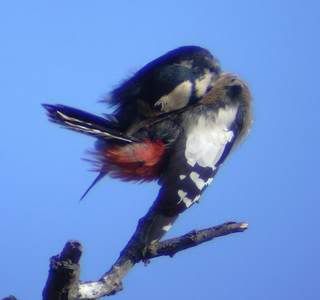 This excellent photo of an adult female Great Spotted Woodpecker preening was taken in Budapest, Hungary (Szabolcs Kokay). Even on this unusual view all the key features indicating the species can be seen: red undertail coverts and ventral area, white outer tail feathers and complete post-auricular stripe. The lack of red on the nape denotes a female.
This excellent photo of an adult female Great Spotted Woodpecker preening was taken in Budapest, Hungary (Szabolcs Kokay). Even on this unusual view all the key features indicating the species can be seen: red undertail coverts and ventral area, white outer tail feathers and complete post-auricular stripe. The lack of red on the nape denotes a female.
Great Spotted Woodpecker: adult female ID
Subscribe to:
Comments (Atom)

